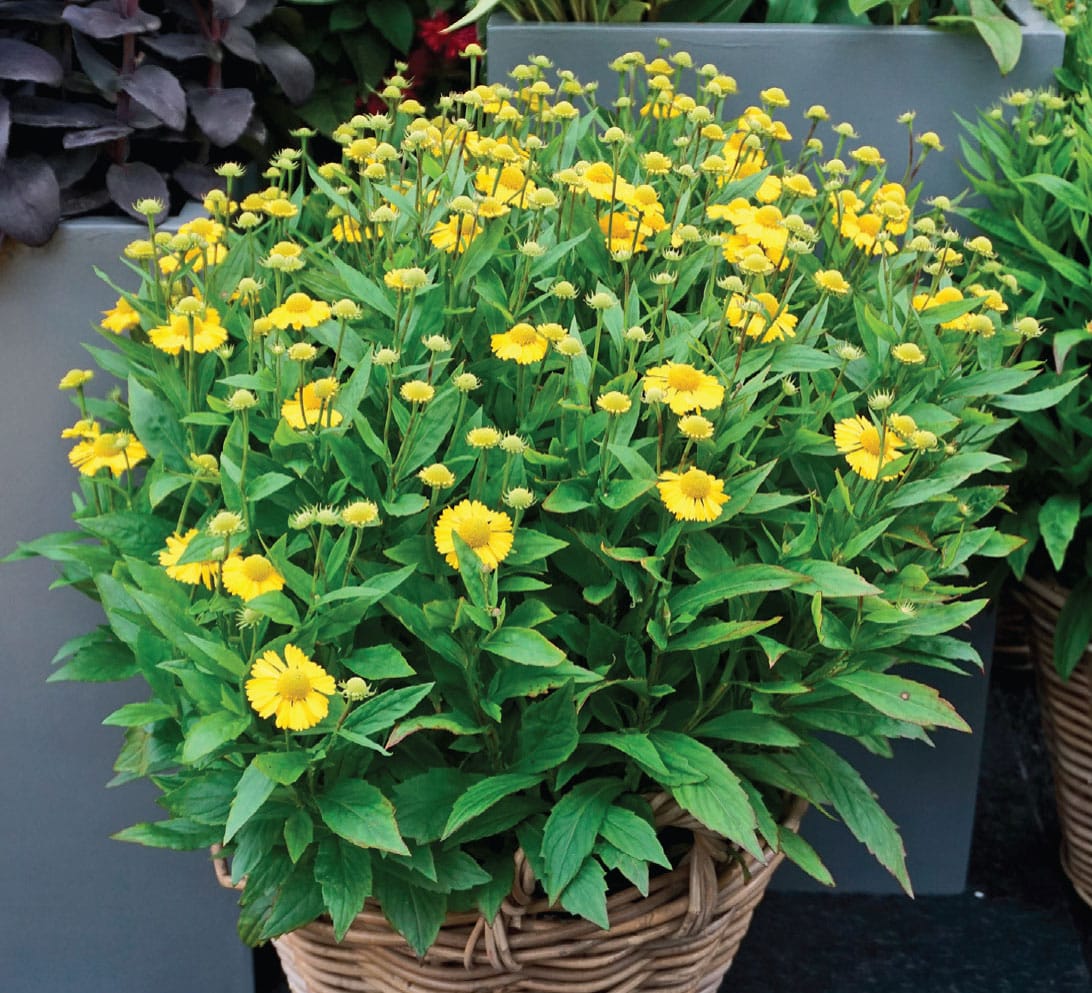5
MORE COMPACT PLANTS FOR THE YARD AND LANDSCAPE:
40 Profiles
In this chapter, let’s take a deep dive into the world of compact plants by viewing detailed profiles of 40 more exceptional plants for small spaces. They’re divided into three distinct categories based on their growth habit: shrubs, trees, and perennials. Edible plants, including herbs, vegetables, and fruits, are featured in the next chapter. Each plant profile found here includes specifics on the appearance and hardiness of the highlighted plant, along with details about its mature dimensions and preferred growing conditions. You’ll also find a special section for each plant that features additional useful information to help ensure your success.
Keep in mind, though, that this is a collection of basic growing information for these plants, but the performance of each variety is also based on the precise growing conditions of your climate and how well you take care of whatever you plant. Gardeners in northern climates are likely to have different results than those growing in warm southern areas. And those who pay careful attention to the needs of each plant in terms of its care and maintenance are sure to see better results than those who completely ignore the garden soon after it’s planted. The maintenance tips offered in chapter 2 will help ensure your success, no matter which compact plants you decide to include in your garden.
Let’s get rolling and meet more of my favorite compact plants.

SHRUBS
Firefly™ Nightglow™ Diervilla
COMMON NAME: Firefly™ Nightglow™ Diervilla
BOTANICAL NAME: Diervilla splendens ‘El Madrigal’
PLANT TYPE: Flowering shrub; deciduous
MATURE DIMENSIONS: 2 to 3 feet tall and equally as wide
HARDINESS: Winter hardy down to –30°F (USDA Zones 4–8)
IDEAL SUN CONDITIONS: Full sun
PHYSICAL APPEARANCE: Bright yellow, trumpet-like flowers, combined with dark red foliage, make this dwarf red-leaved bush honeysuckle a real standout. Clusters of blooms top the branches from early summer through fall, with peak bloom occurring in midsummer, when hummingbirds and other pollinators visit this small shrub in droves. In autumn, the burgundy-red foliage color deepens even more.
CARE REQUIREMENTS: Firefly™ Nightglow™ Diervilla thrives in well-drained soil that’s slightly acidic. It has low water requirements once it’s established but needs to be regularly irrigated for the first year or two. After that, this sporty little shrub tolerates both drought and heat.
EXTRA INFO: Because of its pollinator appeal, this compact Diervilla makes a great addition to a small-scale pollinator garden. It’s a terrific edging plant, too, adding curb appeal to sidewalk beds and foundation plantings.
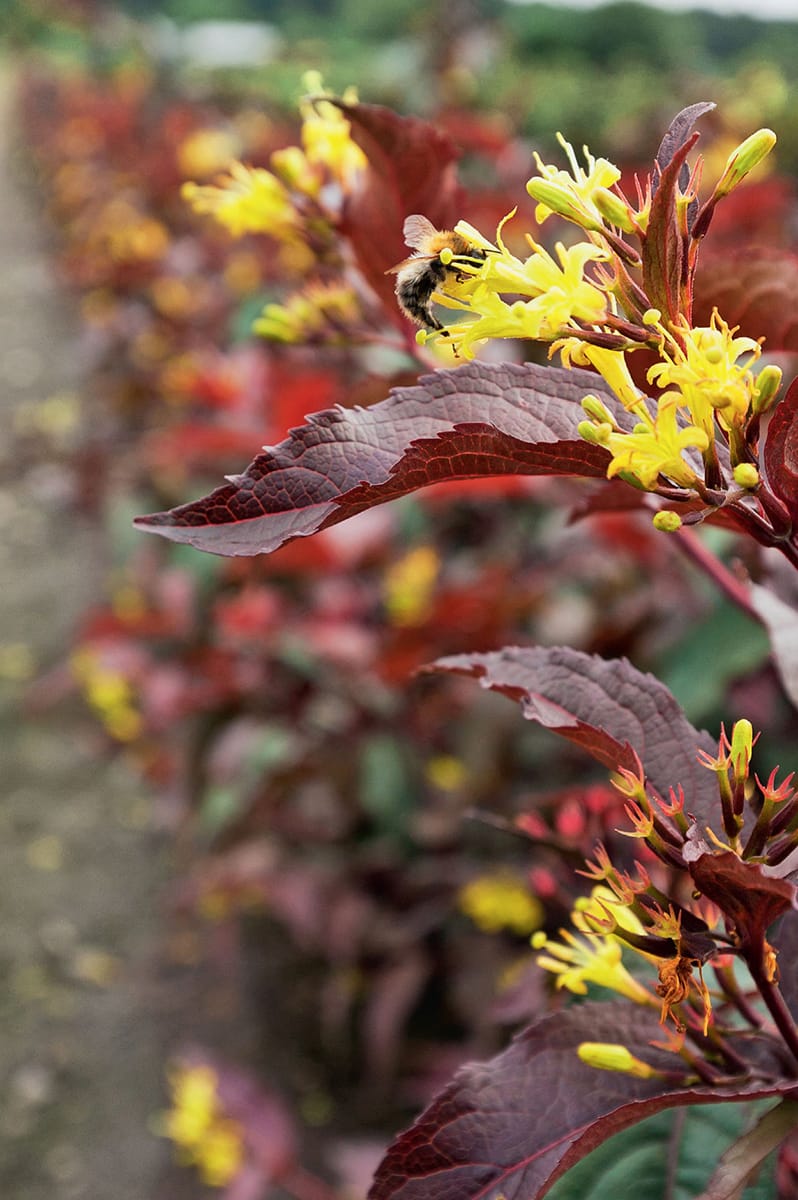
Sugartina® Crystalina Clethra
COMMON NAME: Sugartina® Crystalina Clethra
BOTANICAL NAME: Clethra alnifolia ‘Crystalina’
PLANT TYPE: Flowering shrub; deciduous
MATURE DIMENSIONS: 2 to 3 feet tall; equal width
HARDINESS: Winter hardy down to –30°F (USDA Zones 4–9)
IDEAL SUN CONDITIONS: Partial to full sun
PHYSICAL APPEARANCE: Summersweet has long been a personal favorite of mine for both its form and its flowers. This compact variety is extra sensational because it fits in tight quarters without complaint. The fragrant, creamy-white, oval flower puffs appear in midsummer, luring in butterflies and other pollinators. Oval green leaves turn a striking yellow color in autumn, and its natural mounding habit means it’s suitable to many different garden environments.
CARE REQUIREMENTS: Clethra, in general, requires minimal maintenance, but Sugartina® Crystalina is even more carefree, since little, if any, pruning is required. If you must prune to remove dead growth or limit its size even further, early spring is the best time to do so. It thrives in average garden soil and even tolerates damp areas without missing a beat.
EXTRA INFO: This is a compact cultivar of a North American native plant. It’s deer resistant, and the sweet fragrance of the flowers is always a nice surprise when the plant first comes into flower.
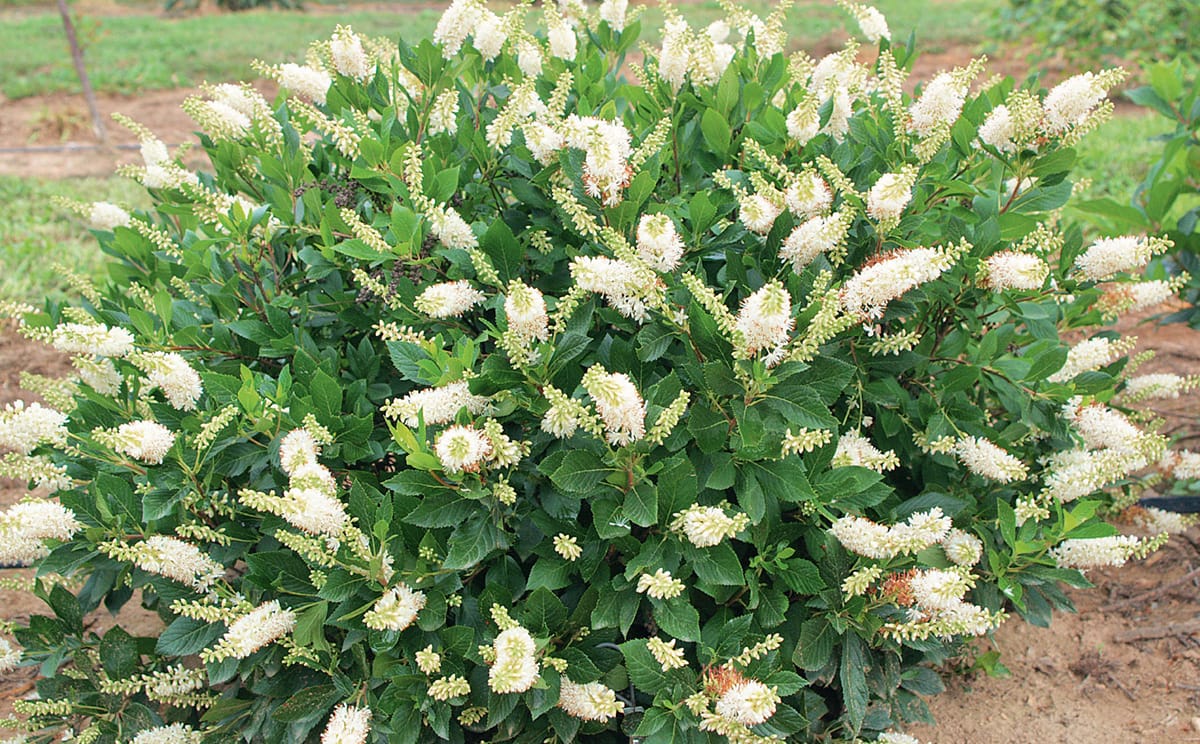
Bobo® Panicle Hydrangea
COMMON NAME: Bobo® Panicle Hydrangea
BOTANICAL NAME: Hydrangea paniculata ‘ILVOBO’
PLANT TYPE: Flowering shrub; deciduous
MATURE DIMENSIONS: 2 to 3 feet tall; 3 to 4 feet wide
HARDINESS: Winter hardy down to –40°F (USDA Zones 3–8)
IDEAL SUN CONDITIONS: Full to partial sun
PHYSICAL APPEARANCE: A spectacular dwarf hydrangea that bears full-size blooms on an itty-bitty plant. Large, white, conical panicles of flowers occur in summer on strong, upright stems that do not require staking. This prolific bloomer is in flower for months; the blooms progress to pink as they age, and they dry beautifully. Bobo’s mounding habit and lush green foliage mean it’s beautiful in the spring, too, even before the plant comes into flower.
CARE REQUIREMENTS: A compact hydrangea that tolerates average garden soil, Bobo® also performs well in containers, though it will wilt if not regularly watered. A member of the paniculata group, this variety blooms on new wood, so pruning in the early spring will not affect the flower production for the coming season like it does for some other types of hydrangeas. You can even prune Bobo® all the way down to the ground in March and it will be in full bloom just a few months later.
EXTRA INFO: There’s another lovely petite hydrangea called Little Lime™ that grows a bit taller than Bobo® but is equally as winter hardy. Its flowers are a striking lime green that ages to a soft pink.

Lil’ Ditty® Witherod Viburnum
COMMON NAME: Lil’ Ditty® Witherod Viburnum
BOTANICAL NAME: Viburnum cassinoides ‘SMNVCDD’
PLANT TYPE: Flowering shrub; deciduous
MATURE DIMENSIONS: 1 to 2 feet tall; 2 to 3 feet wide
HARDINESS: Winter hardy down to –40°F (USDA Zones 3–8)
IDEAL SUN CONDITIONS: Full to partial sun
PHYSICAL APPEARANCE: This is among the most beautiful space-saving plants available to home gardeners. It’s prized for multiple seasons of interest. Puff balls of creamy-white, fragrant flowers occur every spring atop bright green foliage. The flowers are very long lasting and are borne prolifically on this compact, mounding shrub. Soon after bloom, the plant produces round berries that start green, then progress to pink, red, and eventually near-black, and persist on the plant well into winter (or whenever the songbirds find them!). The presence of two or more plants improves pollination and fruit set.
CARE REQUIREMENTS: Like most viburnums, this variety is adaptable to a wide range of growing conditions and soils. It blooms on old wood, so any pruning should occur immediately after flowering, though pruning is seldom required at all. Moist but well-drained soils are best. Lil’ Ditty® is tolerant of moderately wet areas, too.
EXTRA INFO: Lil’ Ditty® is a dwarf cultivar of a North American native plant. It’s deer resistant and very adaptable, making it perfect for foundation plantings, shrub borders, and perennial garden accents.

My Monet® Weigela
COMMON NAME: My Monet® Weigela
BOTANICAL NAME: Weigela florida ‘Verweig’
PLANT TYPE: Flowering shrub; deciduous
MATURE DIMENSIONS: 12 to 18 inches tall; 2 feet wide
HARDINESS: Winter hardy down to –30°F (USDA Zones 4–6)
IDEAL SUN CONDITIONS: Full to partial sun
PHYSICAL APPEARANCE: This colorful little shrub definitely deserves to have Monet’s name included in its own. The foliage is green with a creamy-white variegated edge that turns pink in full-sun conditions. Every spring, the stems are loaded with pink trumpet-like blooms that are long lasting and adored by various pollinators, including hummingbirds and butterflies. If the plant is happy, you’ll occasionally see sporadic fall flowering as well.
CARE REQUIREMENTS: The tight growth habit of My Monet® means it needs no pruning. It’s deer resistant but won’t tolerate waterlogged soils. Weigela’s don’t perform well in hot climates, so avoid planting them in southern regions.
EXTRA INFO: This sweet shrub makes quite a statement in a mass planting around a patio’s edge or in containers on a sunny balcony or deck.

Lil’ Kim® Rose-of-Sharon
COMMON NAME: Lil’ Kim® Rose-of-Sharon
BOTANICAL NAME: Hibiscus syriacus ‘Antong Two’
PLANT TYPE: Flowering shrub; deciduous
MATURE DIMENSIONS: 3 to 4 feet tall; equal spread
HARDINESS: Winter hardy down to –20°F (USDA Zones 5–9)
IDEAL SUN CONDITIONS: Full sun
PHYSICAL APPEARANCE: Half the size of a regular rose-of-Sharon, Lil’ Kim® produces dozens of flowers on each and every stem. Blooms are 3 inches wide and white with a central red-pink marking on each petal. And, to sweeten the deal even more, it’s in bloom all summer long! The upright growth habit keeps the blooms unspoiled and makes Lil’ Kim® a great choice for containers.
CARE REQUIREMENTS: Like other rose-of-Sharon bushes, this compact variety is very forgiving of lousy soil, heat tolerant, drought tolerant, and salt tolerant. Though pruning is seldom needed, this shrub blooms on new wood, so pruning should always occur in the early spring.
EXTRA INFO: Lil’ Kim® is so easygoing that it’s said to bloom beautifully even in its first year. Blooms are attractive to bees and butterflies, and the plants are deer resistant.

Elsdancer Tiny Dancer™ Lilac
COMMON NAME: Elsdancer Tiny Dancer™ Lilac
BOTANICAL NAME: Syringa vulgaris ‘Elsdancer’
PLANT TYPE: Flowering shrub; deciduous
MATURE DIMENSIONS: 4 to 5 feet tall; 3 to 4 feet wide
HARDINESS: Winter hardy down to –30°F (USDA Zones 4–8)
IDEAL SUN CONDITIONS: Full to partial sun
PHYSICAL APPEARANCE: Few things rival the fragrance of a spring lilac bloom. This compact variety produces intensely fragrant, lavender-blue flower clusters in May and June that are 4 to 5 inches long and very full. The large, heart-shaped leaves are a great backdrop for the blooms. This is a great plant for foundations, flower borders, and shrub beds. It also makes an excellent cut flower.
CARE REQUIREMENTS: Tiny Dancer™ lilac prefers moist, but well-drained soil with average fertility. It’s remarkably heat tolerant. Requiring minimum care, this dwarf lilac blooms on old wood, so prune only after flowering.
EXTRA INFO: As an added bonus, this lilac is both powdery mildew resistant and heat tolerant, making it a good choice for southern regions where most lilacs won’t grow well.
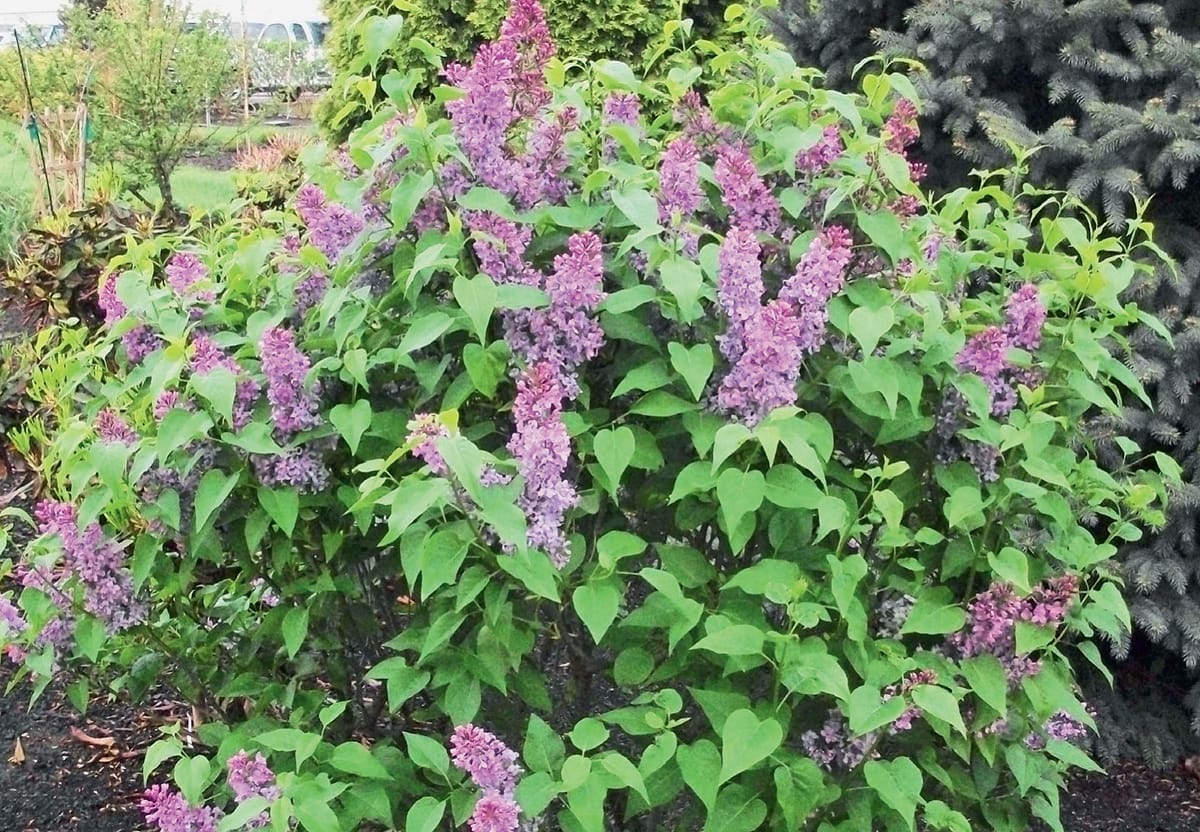
Sugar Plum Fairy® Lilac
COMMON NAME: Sugar Plum Fairy® Lilac
BOTANICAL NAME: Syringa vulgaris ‘Bailsugar’
PLANT TYPE: Flowering shrub; deciduous
MATURE DIMENSIONS: 4 feet tall and 5 feet wide
HARDINESS: Winter hardy down to –40°F (USDA Zones 3–8)
IDEAL SUN CONDITIONS: Full to partial sun
PHYSICAL APPEARANCE: Smothered in frothy, rosy-pink flowers in late spring through early summer, Sugar Plum Fairy® not only looks good in foundation and flower beds, but it also makes a stunning hedge. The spicy, sweet fragrance of the blooms lures in hummingbirds, butterflies, and other pollinators. This lilac’s leaf shade is medium green, and its growth habit is a loose mound.
CARE REQUIREMENTS: Plan to irrigate this compact shrub during dry periods, but other than that, it’s fairly bulletproof. Avoid planting in waterlogged areas, as it can lead to root rot. Prune immediately after flowering, if any pruning is required at all. Disease resistant.
EXTRA INFO: Sugar Plum Fairy® is one in a series of lilacs known as the Fairytale series. This is the smallest-statured one.

Little Devil™ Ninebark
COMMON NAME: Little Devil™ Ninebark
BOTANICAL NAME: Physocarpus opulifolius ‘Donna May’
PLANT TYPE: Flowering shrub; deciduous
MATURE DIMENSIONS: 3 to 4 feet tall; 3 to 4 feet wide
HARDINESS: Winter hardy down to –40°F (USDA Zones 3–7)
IDEAL SUN CONDITIONS: Full to partial sun
PHYSICAL APPEARANCE: The upright, arching habit of this native woody plant looks spectacular in shrub beds, flower borders, and front-walk plantings. Half the height of a regular ninebark, Little Devil™ has fine-textured foliage that’s dark burgundy. In June, clusters of small, pale pink blooms occur along the branches and make a striking display when combined with the foliage. A smattering of smaller blooms occur off and on throughout the growing season. In fall, small red berries develop. This is a compact shrub that’s very well branched.
CARE REQUIREMENTS: This dwarf ninebark resists powdery mildew and is tolerant of both wet and dry soil conditions. It’s very easy to care for, though if you must prune, be sure to do so just after the blooms fade.
EXTRA INFO: Native to the eastern half of the United States and up into Canada, ninebark is a very adaptable shrub. This compact cultivar makes a great low hedgerow plant for supporting pollinators and other beneficial insects.
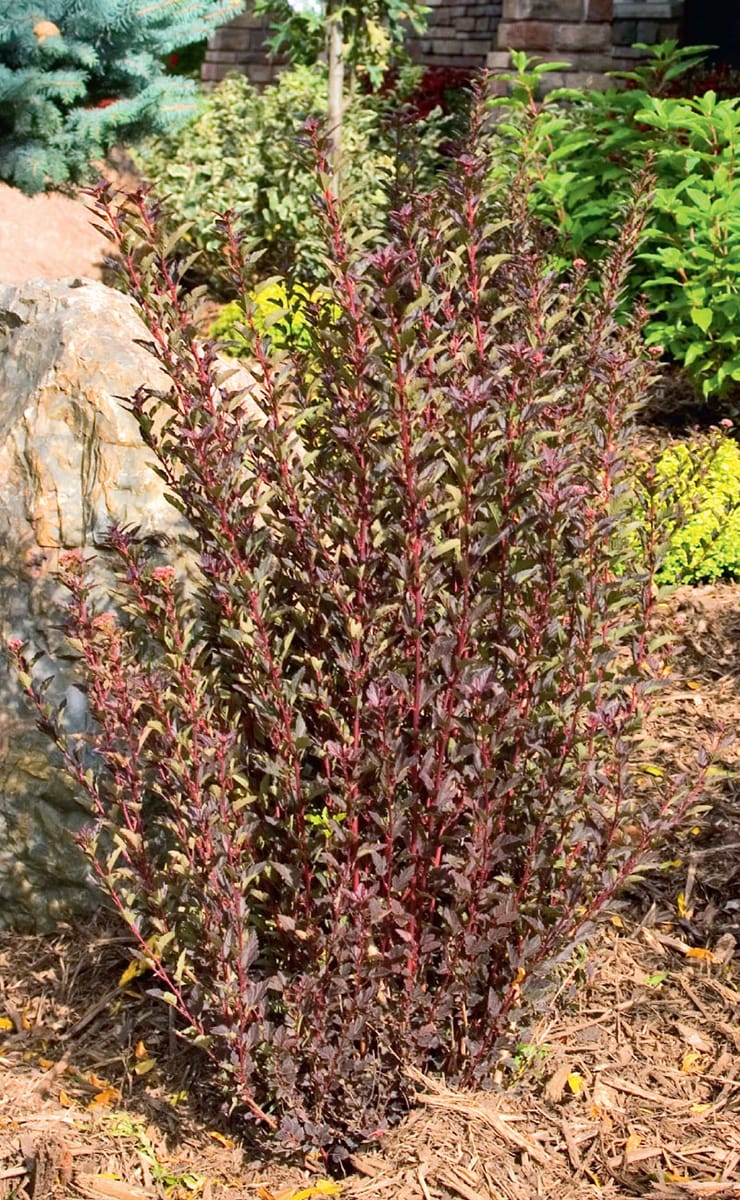
Little Mischief Rose
COMMON NAME: Little Mischief Rose
BOTANICAL NAME: Rosa ‘BAlief’
PLANT TYPE: Flowering woody ornamental
MATURE DIMENSIONS: 2 to 3 feet tall; 2 to 4 feet wide
HARDINESS: Winter hardy down to –30°F (USDA Zones 4–9)
IDEAL SUN CONDITIONS: Full sun
PHYSICAL APPEARANCE: If you’re looking for a little rose to mix into your perennial beds or foundation plantings, Little Mischief is it! This compact rose produces clusters of fragrant, cerise-pink blooms that age to a soft pink. Each bloom is double-petaled and 1 inch across. Its repeat blooming habit means it’s in constant flower from early summer through fall. The foliage is deep green, shiny, and disease resistant. Not only does this dwarf rose look good in beds, it also works beautifully in drifts or container plantings.
CARE REQUIREMENTS: This compact member of the Easy Elegance® rose series requires very little care. All you have to do is make sure it’s well watered for the first two seasons, until the roots become established. Mulch in the spring and deadhead as necessary. No fungicides required.
EXTRA INFO: Unlike many other roses, Little Mischief is not grafted; it’s grown on its own root stock, so there are no worries about burying it too deeply and having another rose sprout from the root stock.
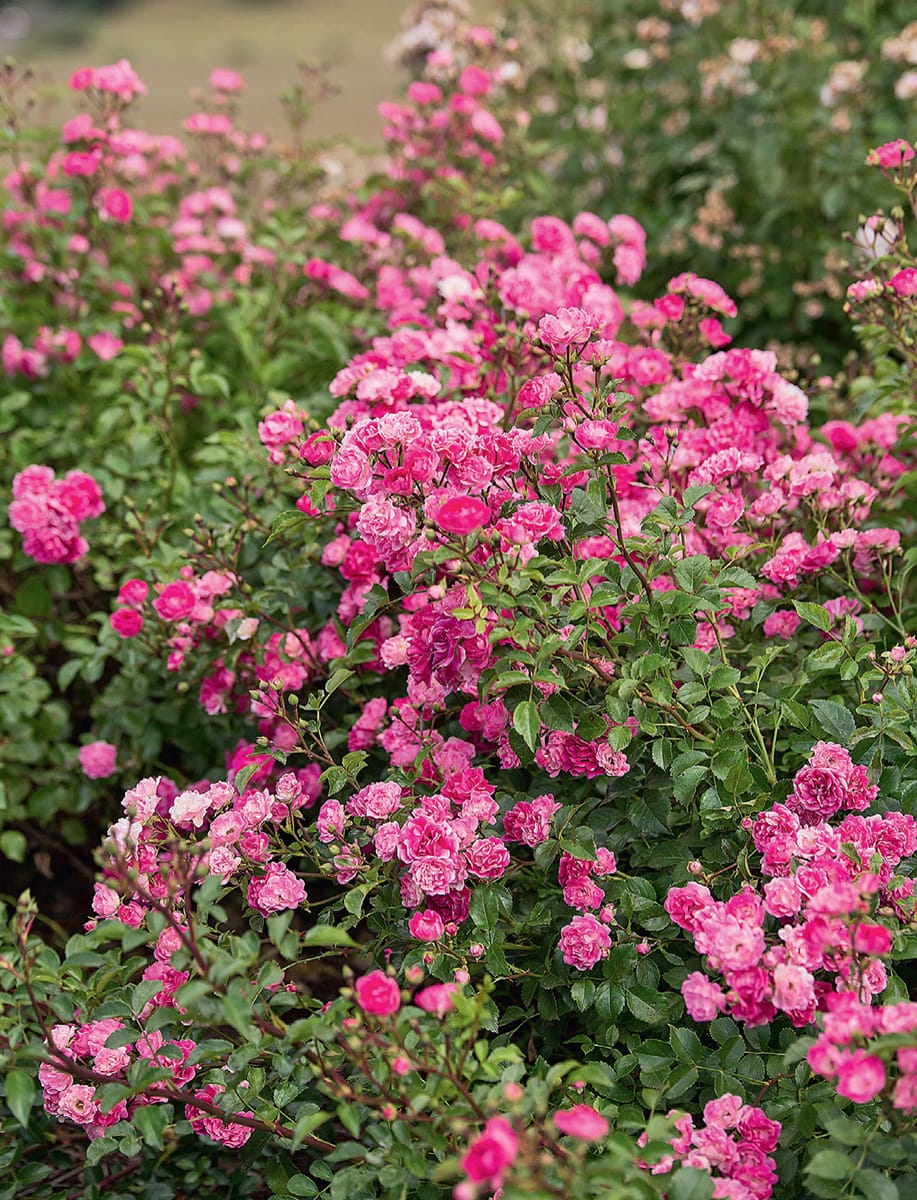
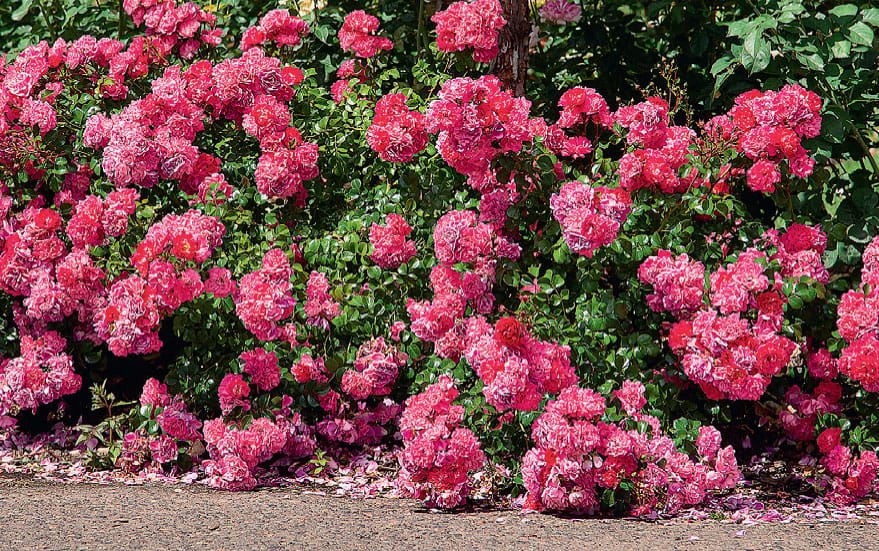
Marge Miller™ Camellia
COMMON NAME: Marge Miller™ Camellia
BOTANICAL NAME: Camellia sasanqua ‘Marge Miller’
PLANT TYPE: Flowering evergreen shrub/groundcover
MATURE DIMENSIONS: 1 foot tall; 3 to 4 feet wide
HARDINESS: Winter hardy down to 0°F (USDA Zones 7–10)
IDEAL SUN CONDITIONS: Partial sun
PHYSICAL APPEARANCE: A quintessential southern beauty, camellias deserve a place in every home garden, but full-sized camellias are far too big for smaller backyards. This dwarf variety acts more like a groundcover than a shrub. Marge Miller’s™ naturally spreading form produces blooms from fall through winter. Plant it at the top of a wall for a shower of cascading, pink, double-petaled blooms that look much like roses. The glossy green foliage is a knockout, too.
CARE REQUIREMENTS: Consistent moisture is key with camellias, so mulch the plants well. This also helps keep roots cool. Use an acid fertilizer after flowering each year to keep the plants in tip-top shape.
EXTRA INFO: This Australian introduction is the first prostrate camellia in the world. It’s a spectacular choice for mass plantings in warm climates.
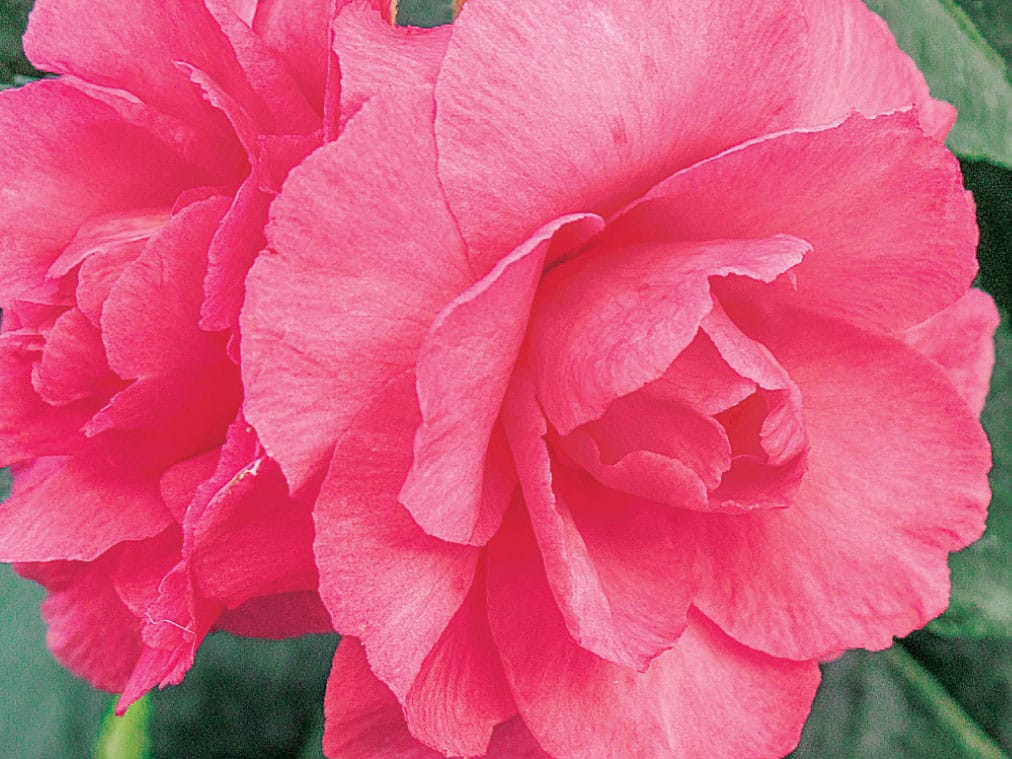
World’s Fair Crape Myrtle
COMMON NAME: World’s Fair Crape Myrtle
BOTANICAL NAME: Lagerstroemia indica ‘World’s Fair’
PLANT TYPE: Flowering shrub; deciduous
MATURE DIMENSIONS: 2 to 3 feet wide; 3- to 4-foot spread
HARDINESS: Winter hardy down to –10°F (USDA Zones 6–8)
IDEAL SUN CONDITIONS: Full sun
PHYSICAL APPEARANCE: Though this plant grows in a limited climate range, the big clusters of watermelon-pink flowers of this crape myrtle can’t be beat. In addition to being a gorgeous addition to flower beds and borders, ‘World’s Fair’ can be used as a groundcover, too. It’s in bloom from late spring through early summer, and its dark, glossy leaves look great even when the plant is not in flower.
CARE REQUIREMENTS: Like other crape myrtles, this compact variety prefers mildly acidic soil conditions and is fairly salt tolerant, making it a good choice for seaside gardens. Crape myrtles bloom on new wood so do any necessary pruning in early spring.
EXTRA INFO: ‘World’s Fair’ is attractive to many pollinators.
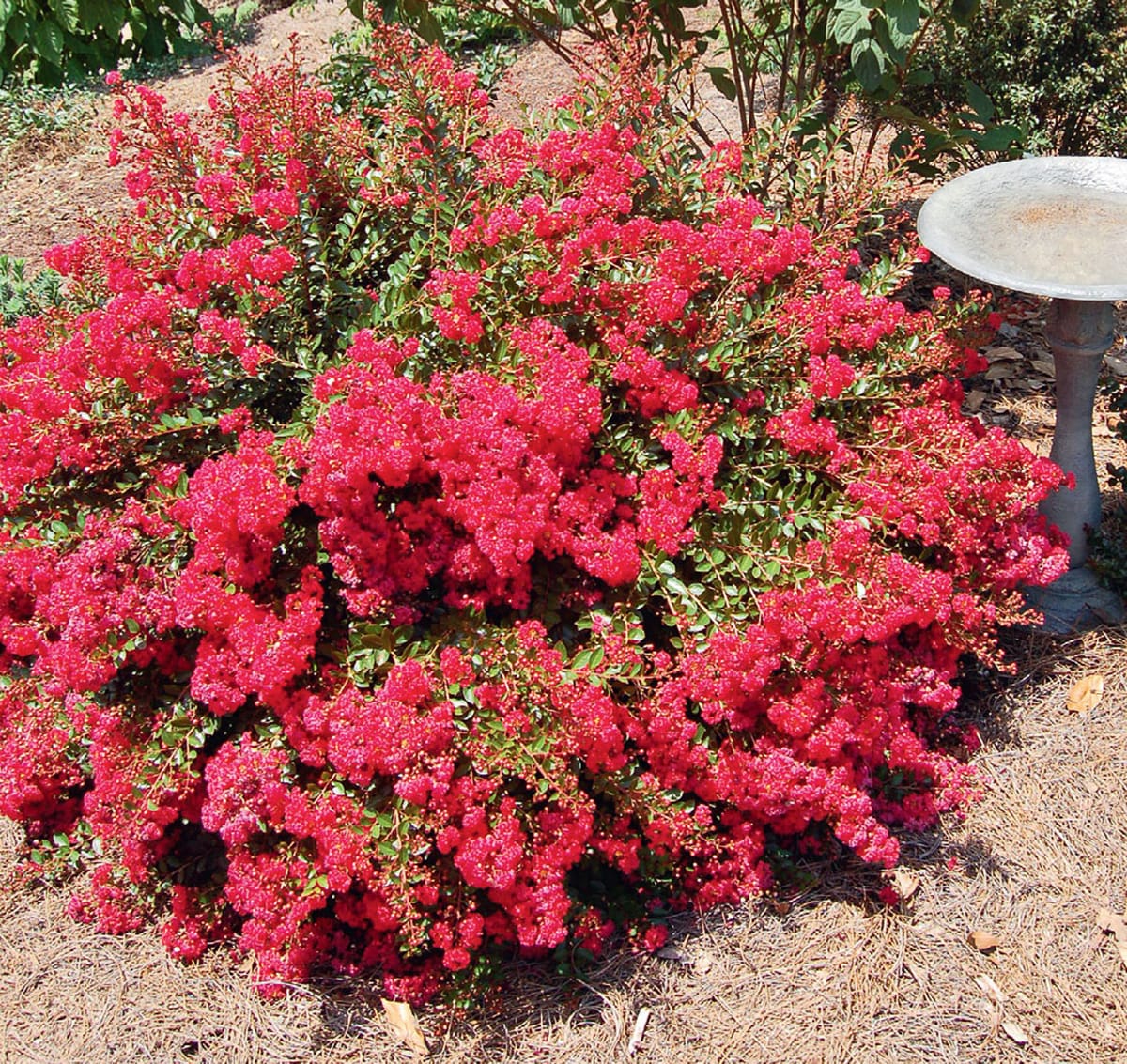
TREES
Shaina Japanese Maple
COMMON NAME: Shaina Japanese Maple
BOTANICAL NAME: Acer palmatum ‘Shaina’
PLANT TYPE: Tree; deciduous
MATURE DIMENSIONS: 6 to 8 feet tall; 8 to 10 feet wide
HARDINESS: Winter hardy down to –20°F (USDA Zones 5–8)
IDEAL SUN CONDITIONS: Full to partial sun
PHYSICAL APPEARANCE: Though Japanese maples in general are lovely small trees for the landscape, ‘Shaina’ Japanese maple is extra special. Its compact form and dense branching habit are perfect for pint-sized gardens. The new foliage is bright red in the spring and then matures to a deep wine-red in summer. Its slow growth rate makes it the ideal tree for container culture, too. Shaina is spectacular under the canopy of larger trees, where it develops even better leaf color.
CARE REQUIREMENTS: Like other Japanese maples, ‘Shaina’ enjoys moist, well-drained soil and requires regular irrigation through dry spells. Acidic soils are best, and be sure to protect this little tree from high winds, especially in the winter. In hot climates, provide shade in the afternoon, as leaf scorch can develop with excessive sun exposure. Little to no pruning is required, though if you must do so, be sure to prune in early winter before the sap starts to run.
EXTRA INFO: This cultivar is an Asian native. Japanese maples are a big family that’s been bred into many different beautiful varieties. Other cultivars for small-scale gardens are ‘Coonara Pygmy’, ‘Beni Kawa’, ‘Murasaki Kiyohime’, ‘Villa Taranto’, ‘Inaba Shidare’, ‘Maiku Jaku’, and ‘Caperci Dwarf’, though most of these grow to twice the height of ‘Shaina’.
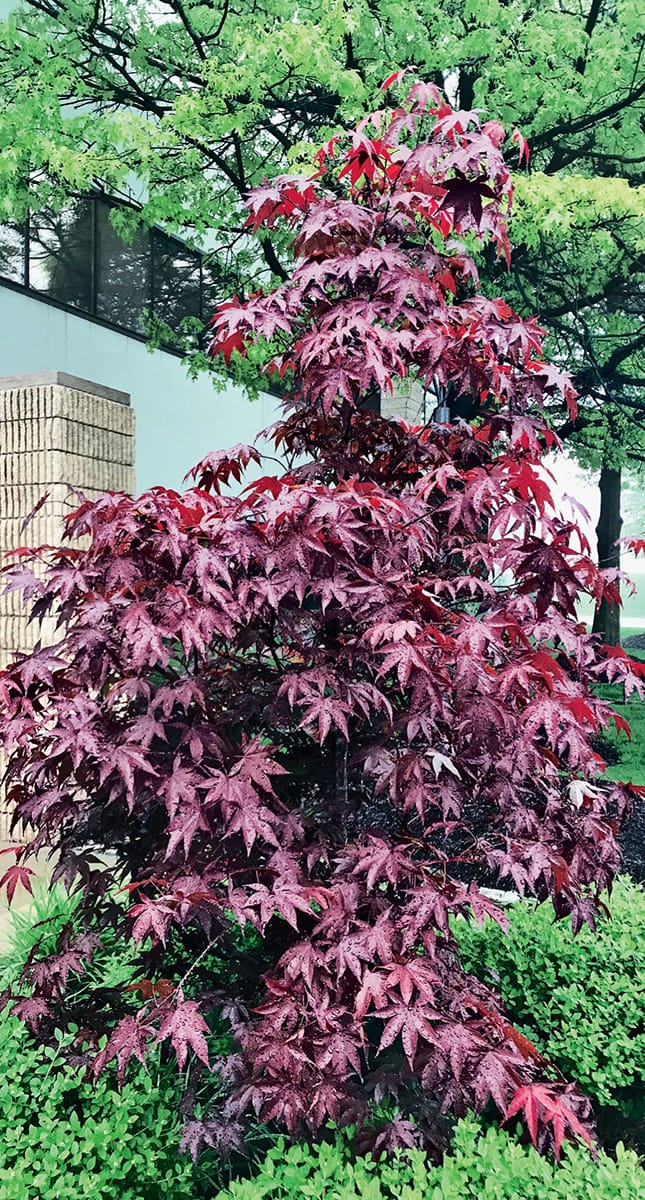
Regent Serviceberry
COMMON NAME: Regent Serviceberry
BOTANICAL NAME: Amelanchier alnifolia ‘Regent’
PLANT TYPE: Multistemmed tree; deciduous
MATURE DIMENSIONS: 4 to 6 feet tall; equal spread
HARDINESS: Winter hardy down to –50°F (USDA Zones 2–7)
IDEAL SUN CONDITIONS: Full to partial sun
PHYSICAL APPEARANCE: Serviceberries are one of my favorite landscape trees, and ‘Regent’ is a serviceberry unlike any other. The only compact serviceberry out there, it’s nothing short of stellar. This upright, multi-branched tree produces purplish leaf growth in the spring, followed by numerous 3/4-inch-wide, five-petaled, fragrant flowers. The leaves then age to a bluish green with light undersides. Dark blue berries follow soon after. The berries are delicious and perfectly edible, if you can beat the birds to them. Oh, and to sweeten the deal, Regent serviceberry also has a beautiful yellow-orange fall color.
CARE REQUIREMENTS: Serviceberries are tolerant of lousy soils, wet soils, drought, and very cold winters. In other words, they’re extremely adaptable. Perform a renewal pruning every few years by removing the oldest stems down to the ground and allowing the younger shoots to develop.
EXTRA INFO: This miniature variety was selected in North Dakota. It is a cultivar of a North American native plant. Pollinators and birds adore it.
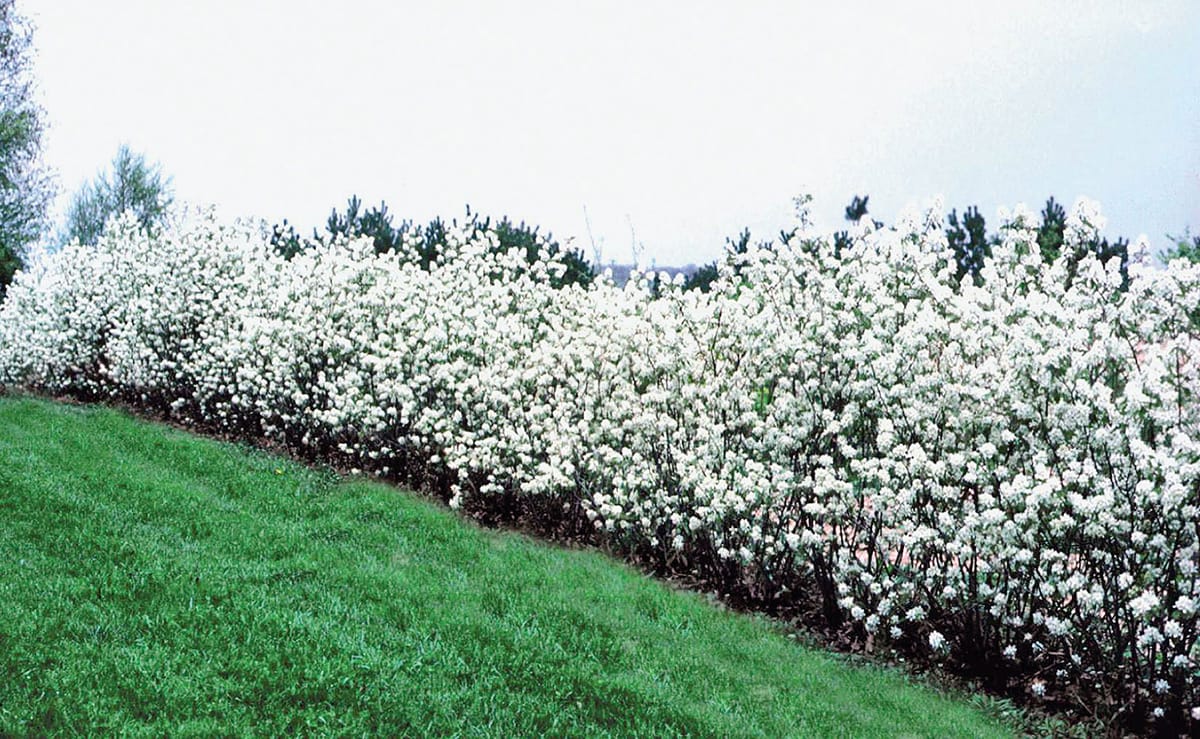
Ace of Hearts Eastern Redbud
COMMON NAME: Ace of Hearts Eastern Redbud
BOTANICAL NAME: Cercis canadensis ‘Ace of Hearts’
PLANT TYPE: Flowering tree; deciduous
MATURE DIMENSIONS: 10 to 12 feet tall; 13 to 15 feet wide
HARDINESS: Winter hardy down to –20°F (USDA Zones 5–9)
IDEAL SUN CONDITIONS: Full to partial sun; full shade in hot climates
PHYSICAL APPEARANCE: Ace of Hearts has all the merits of a full-sized redbud but in a tidy little package. In early spring, expect a powerful burst of tiny, purple-pink blooms held tight to the branches in dense clusters. Soon after bloom, perfectly heart-shaped, green leaves appear, stacked and layered along the branches. The flowers are occasionally followed by flat, bean-like seedpods. This is a cultivar of an eastern North American native tree.
CARE REQUIREMENTS: Redbuds prefer slightly alkaline soil that’s moist but well-drained. Be sure to water this little tree regularly until it’s established. It’s beautiful, naturally dwarf shape means no pruning is necessary.
EXTRA INFO: As if Ace of Hearts weren’t already amazing enough, its yellow fall color is icing on the cake. Plus, the flowers are edible and adored by insect pollinators and hummingbirds, alike.

Sargent Tina Crabapple
COMMON NAME: Sargent Tina Crabapple
BOTANICAL NAME: Malus sargentii ‘Tina’
PLANT TYPE: Flowering tree; deciduous
MATURE DIMENSIONS: 5 feet tall; 6 feet wide
HARDINESS: Winter hardy down to –30°F (USDA Zones 4–8)
IDEAL SUN CONDITIONS: Full sun
PHYSICAL APPEARANCE: Among the smallest crabapples on the market, Sargent Tina is a petite powerhouse. A flush of inch-wide, white flowers bursts from dark pink buds in early spring. The spreading branches and moderate growth rate make Sargent Tina an exceptional urban street tree. The 1/4-inch red fruits are adored by birds in the fall and winter.
CARE REQUIREMENTS: Sargent Tina shows improved pest and disease resistance, so there’s no need to worry about apple scab and other issues. Select a site with well-drained soil and water the tree regularly until it’s established. Any pruning should take place during the winter dormant season. Sargent Tina is typically grafted to create a tree form, so, like other crabapples, don’t plant too deeply or it may develop root suckers.
EXTRA INFO: This tough little tree is a cultivar of an Asian species introduced by Charles Sargent of the Arnold Arboretum at Harvard University. It was then bred to produce ‘Tina’ and several other cultivars.

Apollo® Sugar Maple
COMMON NAME: Apollo® Sugar Maple
BOTANICAL NAME: Acer saccharum ‘Barrett Cole’
PLANT TYPE: Tree; deciduous
MATURE DIMENSIONS: 20 to 25 feet tall; 8 to 10 feet wide
HARDINESS: Winter hardy down to –30°F (USDA Zones 4–7)
IDEAL SUN CONDITIONS: Full sun
PHYSICAL APPEARANCE: If you’re looking for a shade tree that won’t take over a diminutive backyard, Apollo® sugar maple might fit the bill. This narrow, columnar selection of the sugar maple is very symmetrical. Its extraordinary yellow-orange to red fall color follows a deep, luxurious green in the spring and summer. The compact form and dense branching of this shapely tree make it ideal for tight spaces and urban gardens, as long as there’s room for it to grow to its mature height.
CARE REQUIREMENTS: Apollo® is adaptable to various soils but dislikes compaction. This tree is naturally quite shapely, so it seldom needs pruning.
EXTRA INFO: Apollo® sugar maple is a slow-growing cultivar of a North American native species.
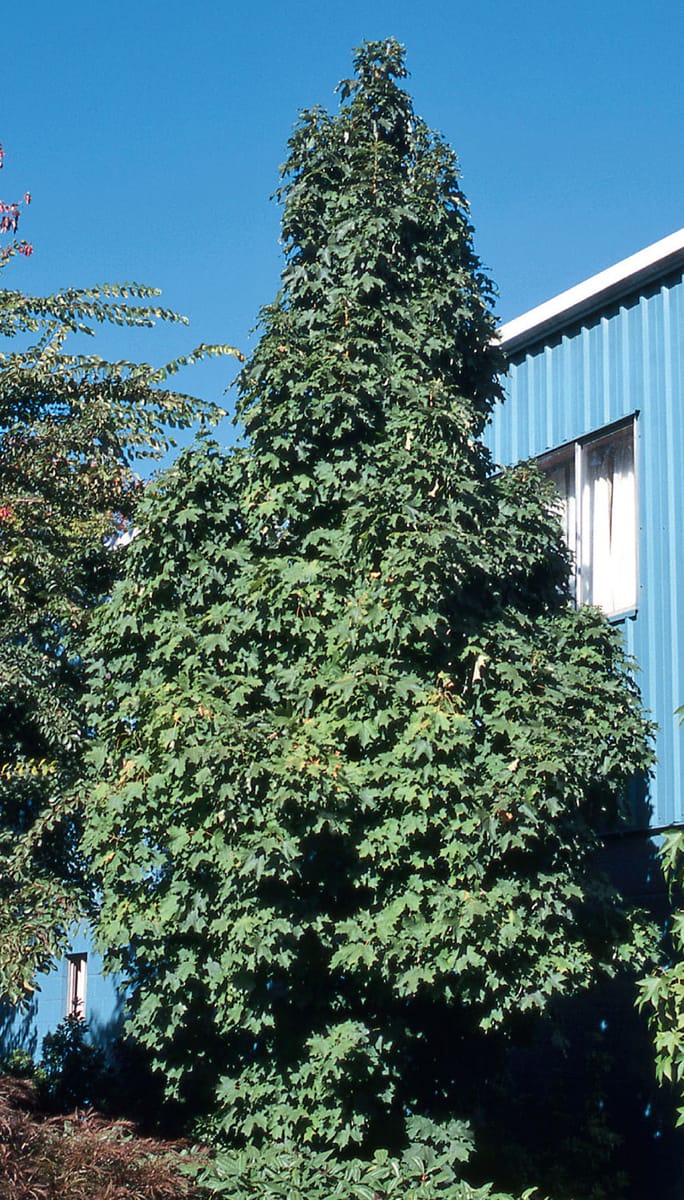
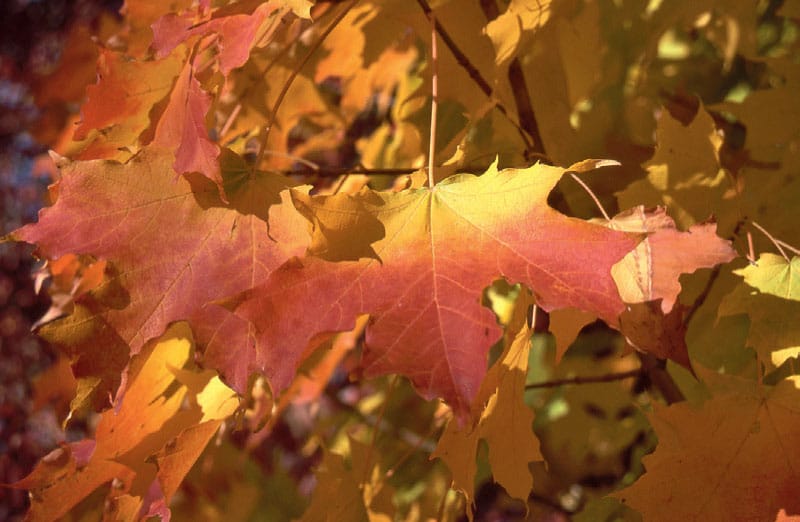
Kikuzaki Dwarf Star Magnolia
COMMON NAME: Kikuzaki Dwarf Star Magnolia
BOTANICAL NAME: Magnolia kobus var. stellata ‘Kikuzaki’
PLANT TYPE: Flowering tree/shrub; deciduous
MATURE DIMENSIONS: 8 to 10 feet tall; 6 to 8 feet wide
HARDINESS: Winter hardy down to –30°F (USDA Zones 4–8)
IDEAL SUN CONDITIONS: Full to partial sun
PHYSICAL APPEARANCE: Half the mature height of standard star magnolias, ‘Kikuzaki’ fits in just about any landscape. Multiple stems and low branching give this tree a shrubby appearance. In very early spring, a plethora of 2- to 3-inch-wide, pale pink to white flowers pop out of the bare branches. The blooms have a soft fragrance and are followed by glossy, dark green leaves that are lighter colored beneath. Its upright growth habit makes it ideal for planting next to patios, porches, and driveways.
CARE REQUIREMENTS: ‘Kikuzaki’ dwarf star magnolia requires well-drained soil and needs to be regularly watered until established. It blooms on old wood, so the buds are formed at the end of the previous season. If you must prune, do so just after blooming.
EXTRA INFO: Even young plants are prolific bloomers, but like other star magnolias, occasionally the buds or flowers may get damaged by hard spring frosts or winter winds. Planting in a sheltered site will help.

Evening Light Japanese Snowbell
COMMON NAME: Evening Light Japanese Snowbell
BOTANICAL NAME: Styrax japonicus ‘Evening Light’
PLANT TYPE: Flowering tree; deciduous
MATURE DIMENSIONS: 10 feet tall; 5 feet wide
HARDINESS: Winter hardy down to –20°F (USDA Zones 5–9)
IDEAL SUN CONDITIONS: Full to partial sun
PHYSICAL APPEARANCE: The striking, dark purple leaves of this Japanese snowbell are awash in white, dangling, heavily fragrant, bell-shaped flowers in late spring and early summer, making it one of the most spectacular flowering displays on any small tree. And, if not subjected to drought, ‘Evening Light’ often reblooms in early fall! The beautiful, vase-like structure of this compact tree is oh so graceful.
CARE REQUIREMENTS: Japanese snowbells thrive in slightly acidic soils rich in organic matter. For maximum bloom power and the best leaf color, plant this petite tree in a sheltered site and keep it well watered, especially during the dry summer months. Prune just after flowering, if you must prune at all.
EXTRA INFO: Its repeat blooming habit makes this small tree extra special. I have one in my front yard, and the pollinators enjoy the dangling flowers as much as I do. Plus, the bark is beautiful in the winter.

Wedding Bells Carolina Silverbell
COMMON NAME: Wedding Bells Carolina Silverbell
BOTANICAL NAME: Halesia carolina ‘UConn Wedding Bells’
PLANT TYPE: Flowering tree; deciduous
MATURE DIMENSIONS: 20 feet tall; 10 to 15 feet wide
HARDINESS: Winter hardy down to –20°F (USDA Zones 5–8)
IDEAL SUN CONDITIONS: Partial shade
PHYSICAL APPEARANCE: This tree is a slightly more compact form of our native North American Carolina silverbell, and its attractiveness cannot be overstated. The large, hanging blossoms are the reason ‘Wedding Bells’ is its cultivar name. An oval-shaped tree with fine branching, this Halesia’s form is much like an elongated lollipop. Pure white, pendulous, bell-shaped flowers occur in mid-spring, followed by seeds with four “wings.” This tree is best utilized as an understory specimen, as it prefers a protected, partially shaded environment.
CARE REQUIREMENTS: Select a planting site with rich, fertile, well-drained soil. Like other silverbells, slightly acidic soil is best.
EXTRA INFO: ‘Wedding Bells’ makes a striking specimen tree, but it does not tolerate salt, so don’t place it near a road or sidewalk.

Slender Silhouette Sweetgum
COMMON NAME: Slender Silhouette Sweetgum
BOTANICAL NAME: Liquidambar styraciflua ‘Slender Silhouette’
PLANT TYPE: Foliage tree; deciduous
MATURE DIMENSIONS: 30 to 40 feet tall; 4 to 6 feet wide
HARDINESS: Winter hardy down to –20°F (USDA Zones 5–8)
IDEAL SUN CONDITIONS: Full sun
PHYSICAL APPEARANCE: Few trees offer fall color as phenomenal as the sweetgum, but standard varieties are way too big for urban landscapes. This tall, thin cultivar changes all that. Its quick-growing, columnar habit is pretty spectacular. With classic sweetgum star-shaped leaves, ‘Slender Silhouette’ does produce the same round, prickly seed balls as other sweetgums, but not very prolifically. The unique growth habit of this tree will just about knock your socks off.
CARE REQUIREMENTS: Sweetgums are tolerant of a broad range of soil conditions. ‘Slender Silhouette’ requires little, if any, pruning and is very easy to grow. Water regularly until established.
EXTRA INFO: This is a cultivar of a North American native plant species that’s indigenous to coastal regions of the eastern half of North America down to Central America. It will serve as a larval host plant for several species of butterflies and moths.

Amanogawa Japanese Flowering Cherry
COMMON NAME: Amanogawa Japanese Flowering Cherry
BOTANICAL NAME: Prunus serrulata ‘Amanogawa’
PLANT TYPE: Flowering tree; deciduous
MATURE DIMENSIONS: 25 feet tall; 10 to 12 feet wide
HARDINESS: Winter hardy down to –20°F (USDA Zones 5–8)
IDEAL SUN CONDITIONS: Full to partial sun
PHYSICAL APPEARANCE: Another narrow, columnar tree for tight spaces, ‘Amanogawa’ Japanese flowering cherry blooms in early spring. It produces large, semidouble, subtly fragrant, soft pink flowers, followed by bronze-tinted spring foliage that ages to green. The orange fall color is notable as well.
CARE REQUIREMENTS: This Japanese flowering cherry requires regular irrigation until established or during drought. It’s usually produced via grafting, so don’t bury the tree too deeply or suckers may develop.
EXTRA INFO: This Japanese cultivar dates back to the 1880s. Its mature height is pretty standard for a Japanese flowering cherry, but its narrow width makes it a unique member of this extensive family.
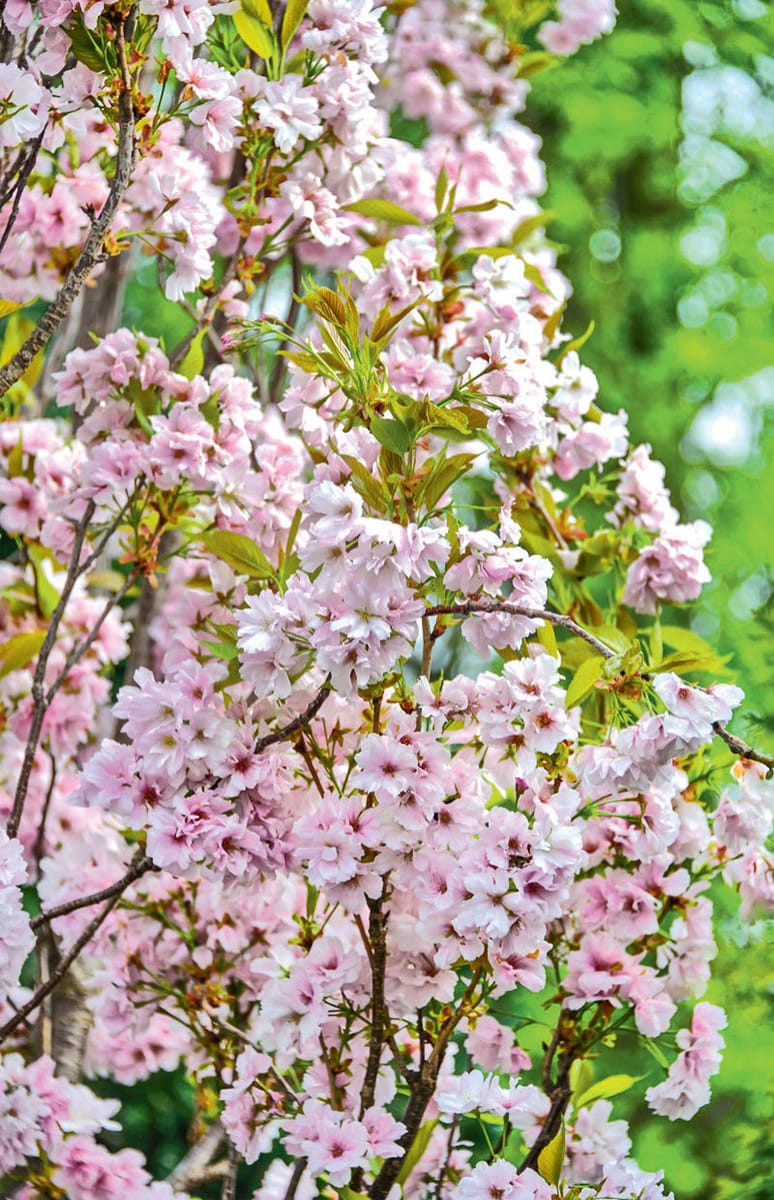
Coralburst® Crabapple
COMMON NAME: Coralburst® Crabapple
BOTANICAL NAME: Malus × ‘Coralcole’
PLANT TYPE: Flowering tree; deciduous
MATURE DIMENSIONS: 8 to 10 feet tall; 12 feet wide
HARDINESS: Winter hardy down to –30°F (USDA Zones 4–8)
IDEAL SUN CONDITIONS: Full sun
PHYSICAL APPEARANCE: Absolutely smothered in semidouble, pink flowers in early spring, this slow-growing, compact crabapple is like no other. The flowers are followed by medium green, disease-resistant leaves and tiny, brownish red fruits that the birds relish. Great for courtyards, patio plantings, and pocket-sized yards.
CARE REQUIREMENTS: Coralburst® crabapples are easy to maintain. They require little to no pruning and are tolerant of a broad range of soil conditions. Drought tolerant once established. Avoid waterlogged soils in low-lying areas.
EXTRA INFO: Extremely resistant to scab, cedar-apple rust, and fireblight, Coralburst® is one of the finest crabapples on the market. It also makes a great pollinator plant for many edible apple varieties.
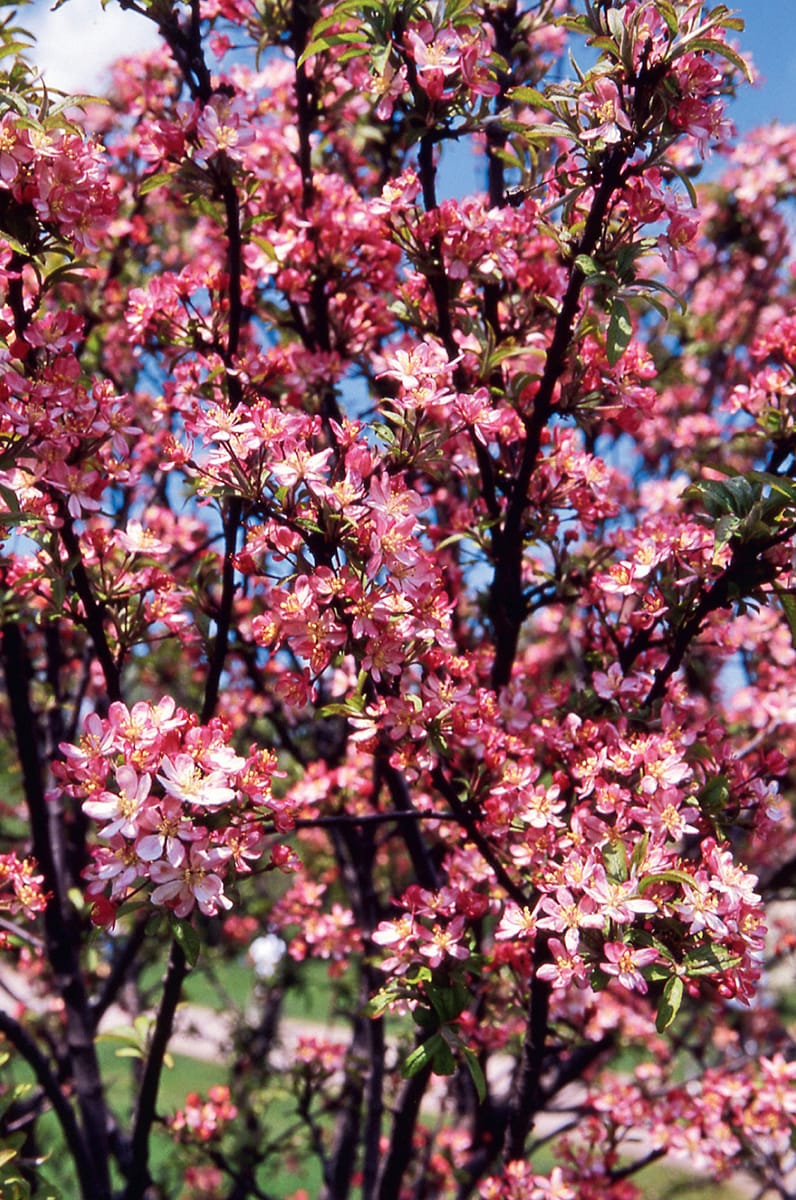
Little Gem Dwarf Southern Magnolia
COMMON NAME: Little Gem Dwarf Southern Magnolia
BOTANICAL NAME: Magnolia grandiflora ‘Little Gem’
PLANT TYPE: Flowering tree; evergreen
MATURE DIMENSIONS: 20 to 25 feet tall; 10 to 15 feet wide
HARDINESS: Winter hardy down to 0°F (USDA Zones 7–9)
IDEAL SUN CONDITIONS: Full sun
PHYSICAL APPEARANCE: Like its full-sized kin, this compact southern magnolia is lush and attractive. The leaves are just as dark green and glossy as traditional southern magnolias, but they’re smaller in size. Large, white, perfumed flowers cover this columnar cultivar in late spring through summer and may occur again in the fall in cooler climates.
CARE REQUIREMENTS: ‘Little Gem’ thrives in acidic, well-drained soil. Add granular, acid-specific fertilizer to the root zone every spring after the plant is established. Prune in winter if you must, but it’s typically not necessary.
EXTRA INFO: While ‘Little Gem’ certainly isn’t as petite as some of the other trees featured here, it is significantly smaller than a standard southern magnolia.
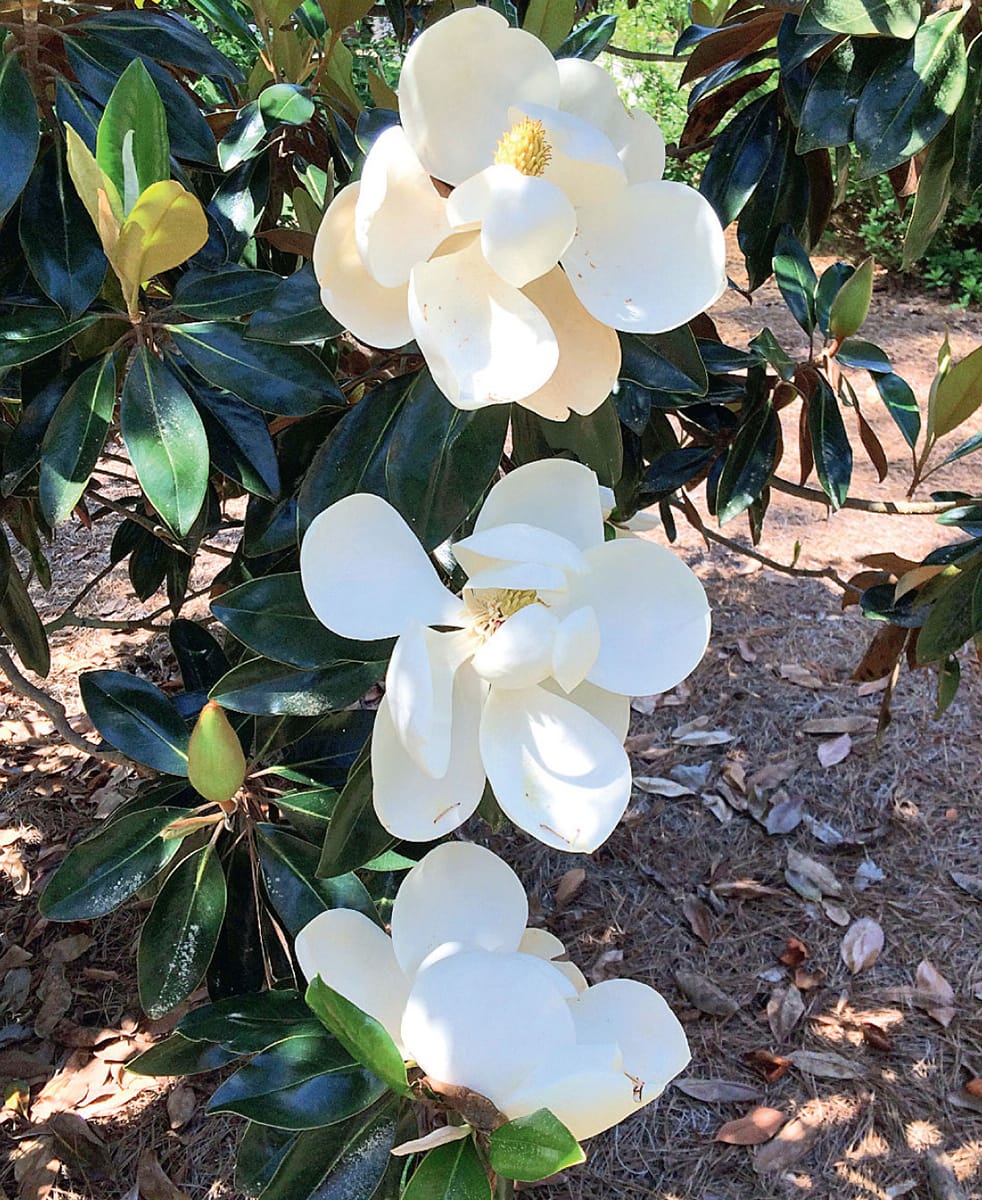
PERENNIALS
While there are plenty of perennials that are naturally short statured (many of which are used as ground covers or at the front of borders and beds), these are compact cultivars of plant species that are typically taller in stature.
Little Giant Purple Coneflower
COMMON NAME: Little Giant Purple Coneflower
BOTANICAL NAME: Echinacea purpurea ‘Little Giant’
PLANT TYPE: Flowering perennial
MATURE DIMENSIONS: 12 to 18 inches tall; 1 foot wide
HARDINESS: Winter hardy down to –40°F (USDA Zones 3–8)
IDEAL SUN CONDITIONS: Full sun
BLOOM TIME: June through August
PHYSICAL APPEARANCE: This tiny-but-mighty coneflower is just as awesome as standard coneflower varieties when it comes to its pollinator prowess and good looks. Five-inch-wide flowers are borne atop short, stocky stems. The bright purply-pink petals surround an orange central disk. Dark foliage is deer resistant. This is a cultivar of a North American native plant.
CARE REQUIREMENTS: Coneflowers are native to moist prairies and meadows, but they’re extremely tolerant of a broad range of growing conditions, including clay-based and dry soils. Divide ‘Little Giant’ every 4 to 5 years or whenever there’s a decline in bloom numbers or the center of the plant starts dying out. This cultivar does not produce viable seeds. Deadhead every week or two to generate subsequent blooms, if desired.

Snowcap Shasta Daisy
COMMON NAME: Snowcap Shasta Daisy
BOTANICAL NAME: Leucanthemum × superbum ‘Snowcap’
PLANT TYPE: Flowering perennial
MATURE DIMENSIONS: 10 to 14 inches tall; 12 inches wide
HARDINESS: Winter hardy down to –30°F (USDA Zones 4–9)
IDEAL SUN CONDITIONS: Full sun
BLOOM TIME: June through August
PHYSICAL APPEARANCE: Shastas are cherished for their bright white, classic daisy-like blooms and tough-as-nails nature, and ‘Snowcap’ offers all of that but in a smaller package. This dwarf variety does not flop, so there’s no staking required. The foliage is dark and glossy, offering a mounding growth habit that stays neat and tidy. Flower stems are all the same height, making the plant look like a cushion of flowers when it’s in bloom. This is an excellent plant for mass plantings.
CARE REQUIREMENTS: ‘Snowcap’ is a drought-, heat-, and humidity-tolerant hybrid. To care for it, simply shear back the flowering stems after blooming, if desired, and divide in the spring every few years. Select a planting site with moist, well-drained soil, though the plant isn’t overly particular about growing conditions.

Grape Knee-Hi Lobelia
COMMON NAME: Grape Knee-Hi Lobelia
BOTANICAL NAME: Lobelia × speciosa ‘Grape Knee-Hi’
PLANT TYPE: Flowering perennial
MATURE DIMENSIONS: 18 to 22 inches tall; 12 to 14 inches wide
HARDINESS: Winter hardy down to –20°F (USDA Zones 5–8)
IDEAL SUN CONDITIONS: Full sun
BLOOM TIME: July through September
PHYSICAL APPEARANCE: This little powerhouse plant attracts hummingbirds, butterflies, and other pollinators. It bears upright spires of purple-blue flowers that stand above a rosette of deep green foliage. This is a hybrid that makes a terrific mass planting and does not require staking to remain upright all season long.
CARE REQUIREMENTS: One of the best compact perennials for low-lying, wet garden areas, ‘Grape Knee-Hi’ shrugs off soggy roots and is an ideal plant for rain gardens and stream-side habitats. But, don’t let that stop you from growing it in average garden soil, because it thrives there, too. A winter mulch of cut evergreen boughs will help see this lobelia through winters where the weather gets extremely cold.

Low Down Willowleaf Sunflower
COMMON NAME: Low Down Willowleaf Sunflower
BOTANICAL NAME: Helianthus salicifolius ‘Low Down’
PLANT TYPE: Flowering perennial
MATURE DIMENSIONS: 12 to 18 inches tall; 18 to 24 inches wide
HARDINESS: Winter hardy down to –10°F (USDA Zones 6–9)
IDEAL SUN CONDITIONS: Full sun
BLOOM TIME: September and October
PHYSICAL APPEARANCE: A groundbreaking cultivar of a North American native plant, this micro-helianthus deserves to be prized by anyone and everyone who gardens in a postage stamp–sized yard. It’s sunny and bold and everything that a perennial sunflower should be! Each blossom consists of a halo of yellow petals surrounding a brown center that’s filled with small native bees all summer long. Dense clusters of flowers cover the entire plant, and the leaves are slender and downward curved. ‘Low Down’ willowleaf sunflower looks lovely in a vase or growing in a garden bed or container.
CARE REQUIREMENTS: Like full-sized helianthus, ‘Low Down’ tolerates clay soil, is deer resistant, and forms a sizeable clump fairly quickly. But, unlike the straight species, this cultivar seldom needs to be divided, pinched, or staked. The seeds of ‘Low Down’ are reportedly sterile.
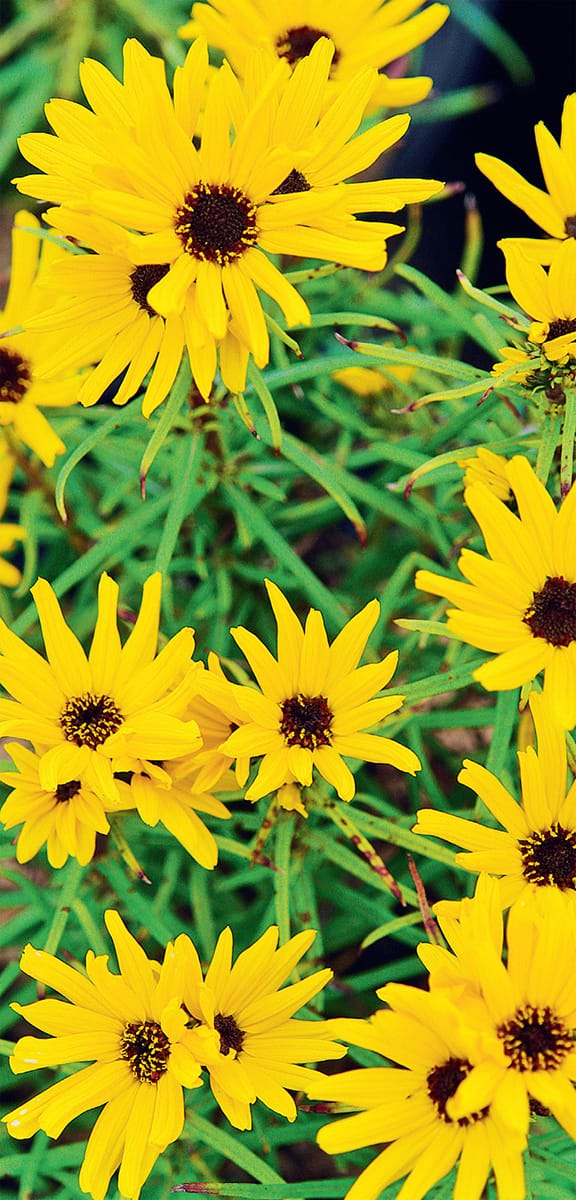
King Edward Yarrow
COMMON NAME: King Edward Yarrow
BOTANICAL NAME: Achillea × lewisii ‘King Edward’
PLANT TYPE: Flowering perennial
MATURE DIMENSIONS: 6 to 8 inches tall; 12 inches wide
HARDINESS: Winter hardy down to –40°F (USDA Zones 3–8)
IDEAL SUN CONDITIONS: Full sun
BLOOM TIME: June through August
PHYSICAL APPEARANCE: The low, carpet-like growth of this hybrid yarrow means it looks great even when the plant isn’t in flower. But, when bloom-time does arrive, the mustard-yellow flowers are borne in clusters at the tops of stems that stand 6 inches above the foliage. The leaves are wooly and serrated and almost fern-like. ‘King Edward’ yarrow brightens up rock gardens, small perennial beds, and even sidewalk edges.
CARE REQUIREMENTS: Like other yarrows, ‘King Edward’ shrugs off heat and humidity, and tolerates salty seaside climates. Average garden soil is best. Give this plant room to spread and shear off dead flower stems after blooming to keep the plant looking tidy and generate a small flush of secondary blooms.

Little Spire Russian Sage
COMMON NAME: Little Spire Russian Sage
BOTANICAL NAME: Perovskia atriplicifolia ‘Little Spire’
PLANT TYPE: Woody flowering perennial
MATURE DIMENSIONS: 18 to 24 inches tall; equal spread
HARDINESS: Winter hardy down to –30°F (USDA Zones 4–9)
IDEAL SUN CONDITIONS: Full sun
BLOOM TIME: June through frost
PHYSICAL APPEARANCE: A cutie-pie cultivar of an Asian native plant that’s typically too floppy and wide spreading for smaller gardens, ‘Little Spire’ Russian sage offers the same wonderful color and long-lasting blooms as its relatives but in a compact form. Wispy, upright spires of blue flowers grace the gray-green foliage of these airy plants. At the end of the growing season, leave the plants in place; their silvery stalks offer winter interest to the garden as well.
CARE REQUIREMENTS: Both deer and rabbit resistant due to its highly fragranced foliage, ‘Little Spire’ is definitely a home run in the care department. Tolerant of dry soil and clay soil, all you have to do to care for the plant is cut it back to the ground in late winter or early spring. No pinching, dividing, or deadheading required.
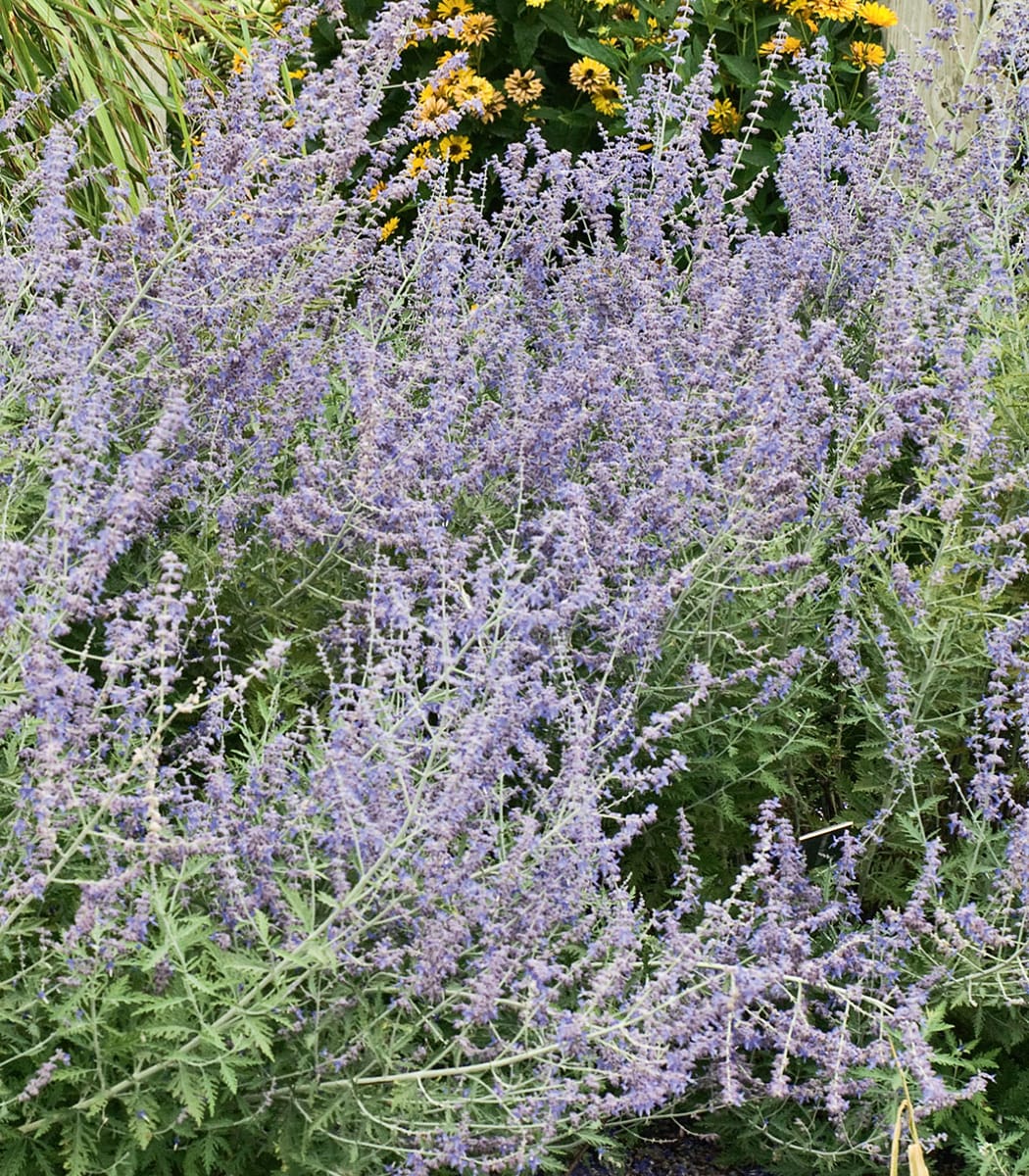
Li’l Bang™ Red Elf Tickseed
COMMON NAME: Li’l Bang™ Red Elf Tickseed
BOTANICAL NAME: Coreopsis × verticillata ‘Red Elf’
PLANT TYPE: Flowering perennial
MATURE DIMENSIONS: 12 inches tall; equal width
HARDINESS: Winter hardy down to –20°F (USDA Zones 5–9)
IDEAL SUN CONDITIONS: Full to partial sun
BLOOM TIME: June through September
PHYSICAL APPEARANCE: Li’l Bang™ coreopsis is a hybrid series derived from one of our North American native plants. There are several different colors in this series, but I like ‘Red Elf’ the best. Rich, velvety-red petals surround the bright yellow centers of its daisy-like blooms. This is a prolific bloomer that’s adored by pollinators, long blooming, and disease resistant. Naturally compact, this perennial is also great for pots.
CARE REQUIREMENTS: Choose a well-drained site for the best performance and shear plants back after blooming to encourage a subsequent flush of blooms and tidy up the plant. Like other coreopsis, ‘Red Elf’ benefits from being divided every few years. The seeds are reportedly sterile.

Volcano® series of Phlox
COMMON NAME: Volcano® series of Phlox
BOTANICAL NAME: Phlox paniculata Volcano® series
PLANT TYPE: Flowering perennial
MATURE DIMENSIONS: 12 to 20 inches tall; 12 to 18 inches wide
HARDINESS: Winter hardy down to –30°F (USDA Zones 4–9)
IDEAL SUN CONDITIONS: Full to partial sun
BLOOM TIME: June through September
PHYSICAL APPEARANCE: Another series of cultivars derived from a North American native plant, Volcano® phlox comes in a broad range of colors, from lilac and pink to red and white. Large, ball-like clusters of 1/2-inch-wide, trumpet-shaped blooms grace the tops of strong, sturdy stems all summer long. No staking required! The blooms are adored by bees, butterflies, and hummingbirds; and they have a long life in both the garden and the vase. The entire Volcano® series is resistant to powdery mildew, making it a great choice for blocks of color in a tiny cottage garden or a more formal perennial bed.
CARE REQUIREMENTS: Cut off spent blooms, plus one-quarter of the stem growth, and this compact perennial will bloom again and again. Choose a well-drained site—soggy soils are a no-no—and be sure to regularly irrigate during extreme heat. Unfortunately, this plant is not deer or rabbit resistant, but it sure is gorgeous!
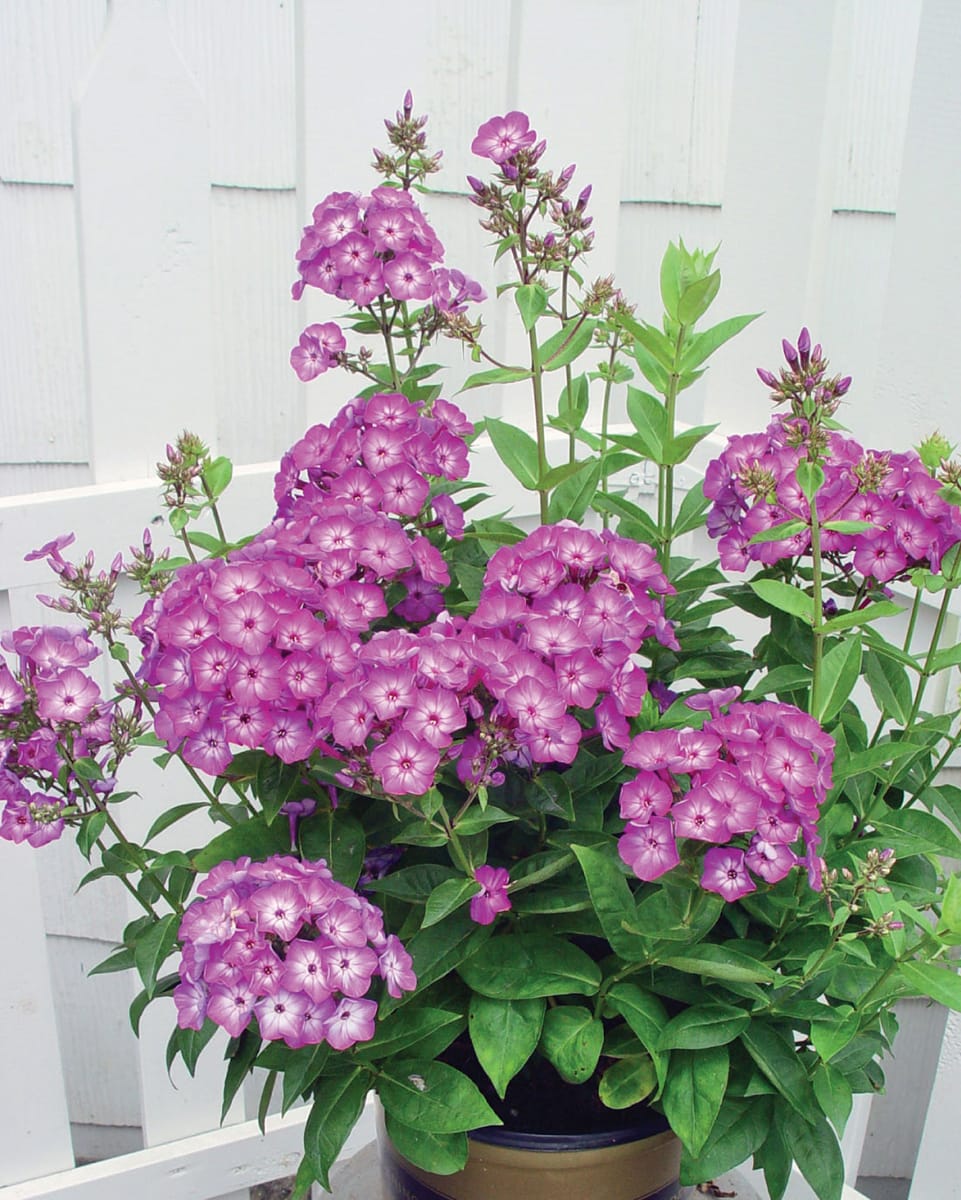
Leading Lady Plum Bee Balm
COMMON NAME: Leading Lady Plum Bee Balm
BOTANICAL NAME: Monarda × ‘Leading Lady Plum’
PLANT TYPE: Flowering annual
MATURE DIMENSIONS: 10 to 14 inches tall; 2 to 3 feet wide
HARDINESS: Winter hardy down to –30°F (USDA Zones 4–8)
IDEAL SUN CONDITIONS: Full to partial sun
BLOOM TIME: June through September
PHYSICAL APPEARANCE: Though I’m particularly fond of the plum-colored cultivar of this hybrid plant, it also comes in other colors, including ‘Leading Lady Lilac’ and ‘Leading Lady Orchid’. Earlier blooming than other bee balms, its clump-forming, compact habit means you can put it front and center without worrying about it taking over the entire garden. The magenta-purple flowers of ‘Leading Lady Plum’ are prized by butterflies, hummingbirds, and bumblebees. Plus, the blooms are edible, the foliage is fragrant, and when dried, both make a great herbal tea.
CARE REQUIREMENTS: Average garden soil will do just fine. Cut off spent blooms to generate a second flush of flowers in late summer. Though it isn’t necessary, an early-spring pinching will keep this compact plant even shorter and delay its blooming by a few days. As with other Monardas, divide the plants when their center starts to die out. This is a hybrid of a North American native plant.
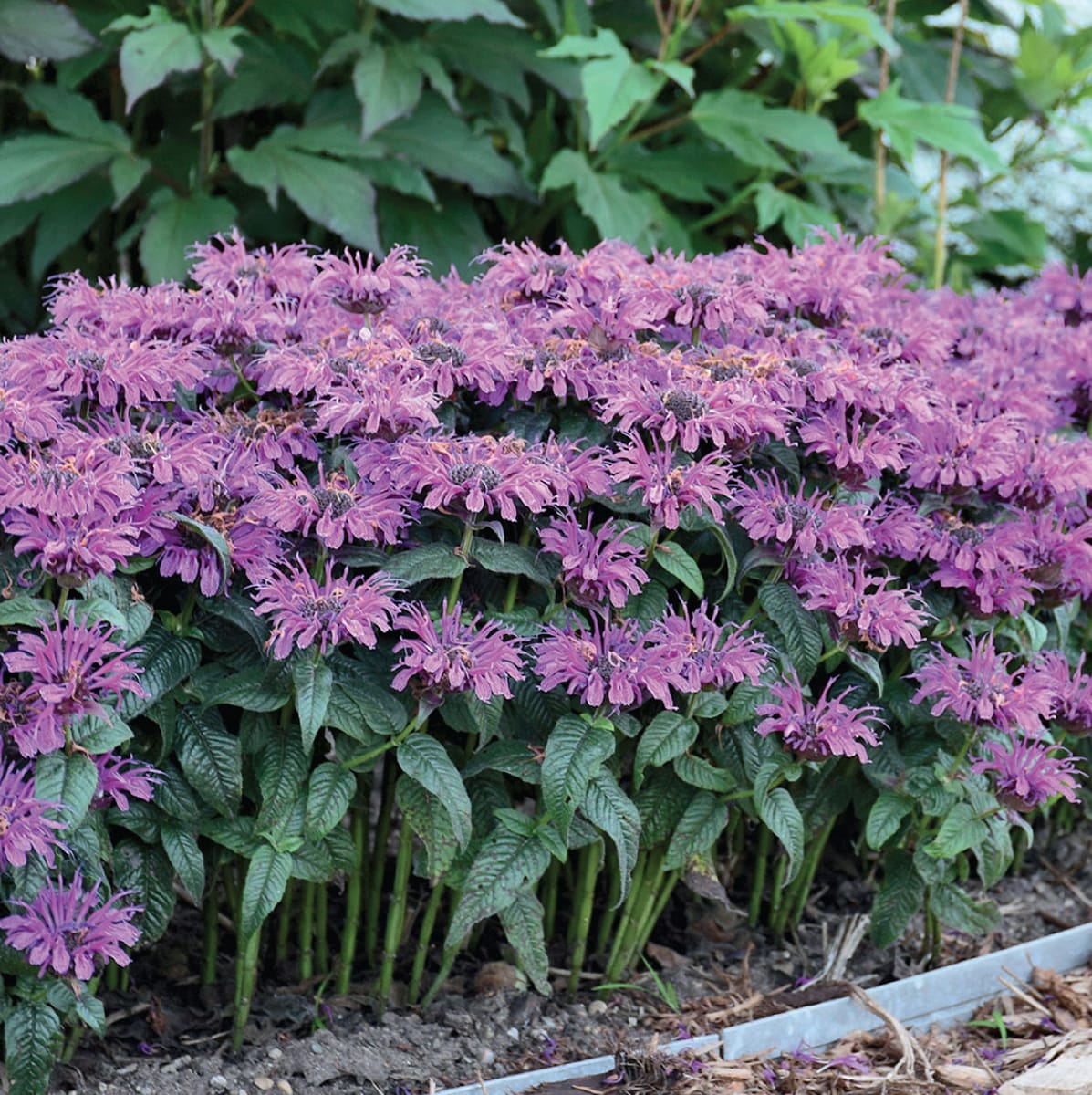
Purple Rock Candy® Beardlip Penstemon
COMMON NAME: Purple Rock Candy® Beardlip Penstemon
BOTANICAL NAME: Penstemon barbatus ‘Novapenpur’
PLANT TYPE: Flowering perennial
MATURE DIMENSIONS: 8 to 12 inches tall; 18 to 24 inches wide
HARDINESS: Winter hardy down to –20°F (USDA Zones 5–8)
IDEAL SUN CONDITIONS: Full to partial sun
BLOOM TIME: June through July
PHYSICAL APPEARANCE: The bold, dark purple flowers of Purple Rock Candy® penstemon have a white throat that calls in pollinators. The upright flowering stems are packed with blooms from top to bottom, and they sit atop green, compact foliage. There are other varieties in the Rock Candy® series, including blue, light pink, and ruby. A cultivar of a western North American native plant, the ground-hugging foliage of this penstemon is partially evergreen, adding an extra layer of interest to the winter garden.
CARE REQUIREMENTS: To maintain this plant, simply trim off the flower stems as they age and a new flush of blooms will appear. Average garden soil is best for this heat- and drought-tolerant variety. Do not plant it in wet, poorly drained soils, however, or root rot will be the likely result.

Thumbelina Leigh English Lavender
COMMON NAME: Thumbelina Leigh English Lavender
BOTANICAL NAME: Lavandula angustifolia ‘Thumbelina Leigh’
PLANT TYPE: Woody flowering perennial; evergreen
MATURE DIMENSIONS: 12 to 18 inches tall; 12 inches wide
HARDINESS: Winter hardy down to –20°F (USDA Zones 5–9)
IDEAL SUN CONDITIONS: Full sun
BLOOM TIME: June through August
PHYSICAL APPEARANCE: Nothing says summer like perfumed wands of lavender flowers. A compact selection of this aromatic herb, ‘Thumbelina Leigh’ is smothered in classic, purple-blue flowers up to three times a year, if the plant is pruned back after each flush of flowers. Disease-free, drought-tolerant, gray-green foliage is great for low-water gardens; but it’s also suited to perennial borders, herb gardens, dry slopes, rock gardens, and shrub beds, too. In fact, you can’t beat this lavender for container growing, either!
CARE REQUIREMENTS: ‘Thumbelina Leigh’ thrives in loose, fast-draining, gravelly soils and will sometimes rot when planted in heavy clay or waterlogged soils. Choose a site accordingly or grow it in a pot filled with a gravelly, sandy potting soil mix. Shear off the spent flowers and half of the growth just after blooming ends to generate a new flush of flowers. Trim the plant back hard in every early spring, just before new growth emerges.

Buzz™ Butterfly Bush Series
COMMON NAME: Buzz™ Butterfly Bush Series
BOTANICAL NAME: Buddleja hybrids Buzz™ series
PLANT TYPE: Woody flowering perennial
MATURE DIMENSIONS: 2 to 3 feet tall; equal spread
HARDINESS: Winter hardy down to –20°F (USDA Zones 5–11)
IDEAL SUN CONDITIONS: Full sun
BLOOM TIME: May through frost
PHYSICAL APPEARANCE: One-third the height of standard butterfly bush varieties, this series produces large flower heads on compact plants. Buzz™ butterfly bushes are early flowering and perfect for pots. Their light fragrance and panicles of tiny, trumpet-like blooms are attractive to butterflies and other pollinators. This series comes in a range of colors from ivory and purple to magenta and lavender.
CARE REQUIREMENTS: For the best performance, prune the plants back hard in the early spring, before new growth emerges. Then, trim off spent flowers to generate more blooms throughout the growing season. There’s no need to pinch or stake this variety. Plus, it’s drought and heat tolerant, once established.

Moody Blues® Dark Blue Speedwell
COMMON NAME: Moody Blues® Dark Blue Speedwell
BOTANICAL NAME: Veronica spicata ‘Novaverblu’
PLANT TYPE: Flowering perennial
MATURE DIMENSIONS: 12 to 14 inches tall; equal spread
HARDINESS: Winter hardy down to –30°F (USDA Zones 4–9)
IDEAL SUN CONDITIONS: Full sun
BLOOM TIME: June through frost
PHYSICAL APPEARANCE: I can’t say enough about this compact veronica. It’s covered with dark purple-blue flower spikes all summer long; the color is outstanding. The densely packed flowers open from the bottom to the top of upright flower spikes that are very long lasting. There’s also a pink and a white veronica in the Moody Blues® series. The foliage is deer resistant and blemish free, and the plant stays very neat and tidy all summer long.
CARE REQUIREMENTS: One established, Moody Blues® speedwell is very drought tolerant, thriving in well-drained, average garden soil. A weekly deadheading promotes new growth and flowering. Plants should be divided every 4 to 5 years.
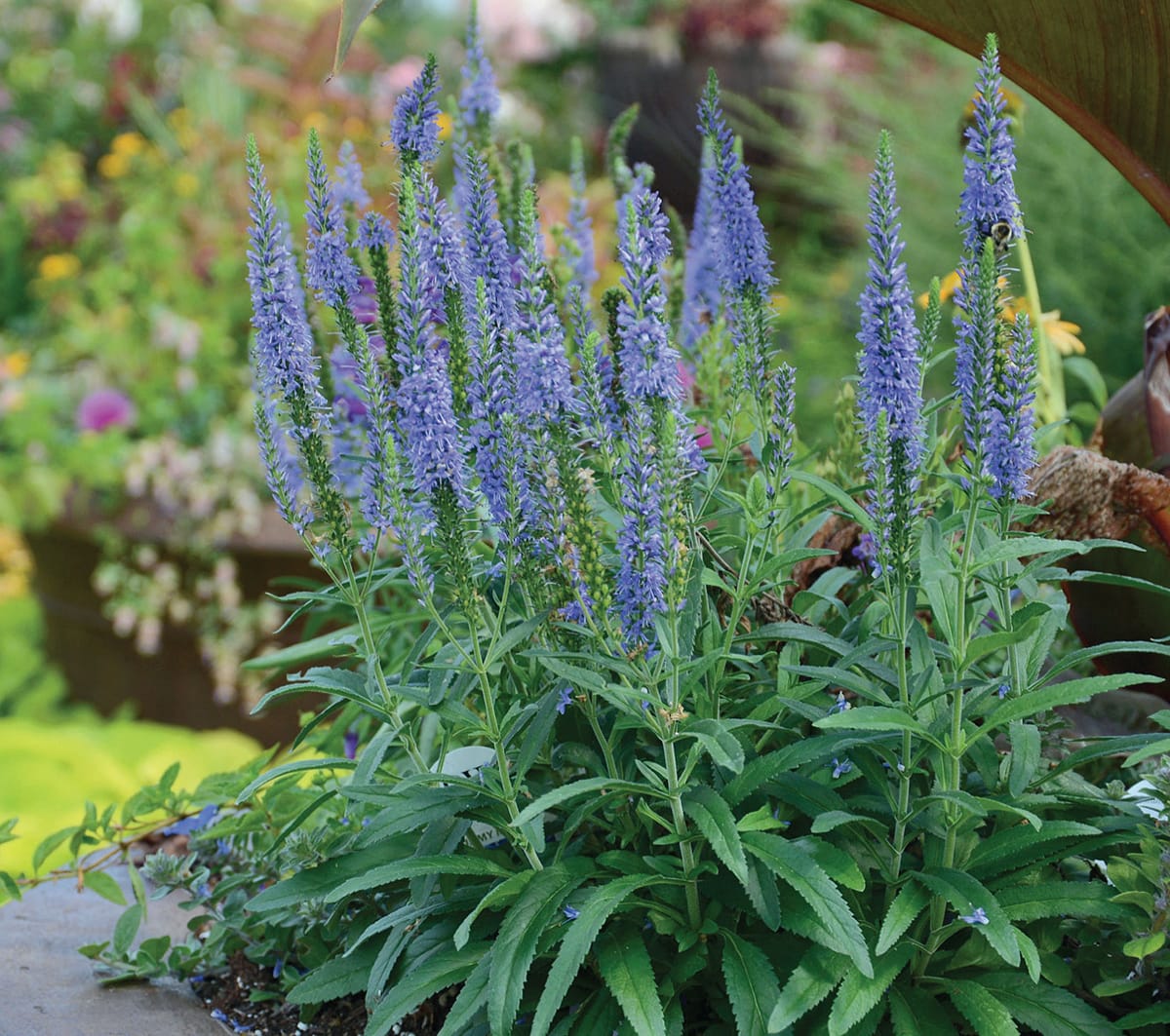
Tiny Tortuga Turtlehead
COMMON NAME: Tiny Tortuga Turtlehead
BOTANICAL NAME: Chelone obliqua ‘Tiny Tortuga’
PLANT TYPE: Flowering perennial
MATURE DIMENSIONS: 18 to 24 inches tall; 12 to 18 inches wide
HARDINESS: Winter hardy down to –30°F (USDA Zones 4–9)
IDEAL SUN CONDITIONS: Full to partial sun
BLOOM TIME: July through frost
PHYSICAL APPEARANCE: With large, hooded, pink flowers borne in clusters at the tops of the stems, this mini turtlehead is a garden wonder. The foliage is a glossy dark green to bronze, and it stands in an upright, rigid clump. There’s no need to stake this plant, even in the shade. This cultivar of a North American native plant is lovely even when it isn’t in flower.
CARE REQUIREMENTS: A low-maintenance workhorse, ‘Tiny Tortuga’ turtlehead is easy as can be. There’s no need to pinch, prune, or deadhead. Like other turtleheads, this variety does excellent in moist, low-lying areas, making it ideal for woodland or bog gardens. It’s slow to emerge from the ground in the spring, so give it some extra time. Turtlehead prefers soils high organic matter; work plenty of compost into the planting site.
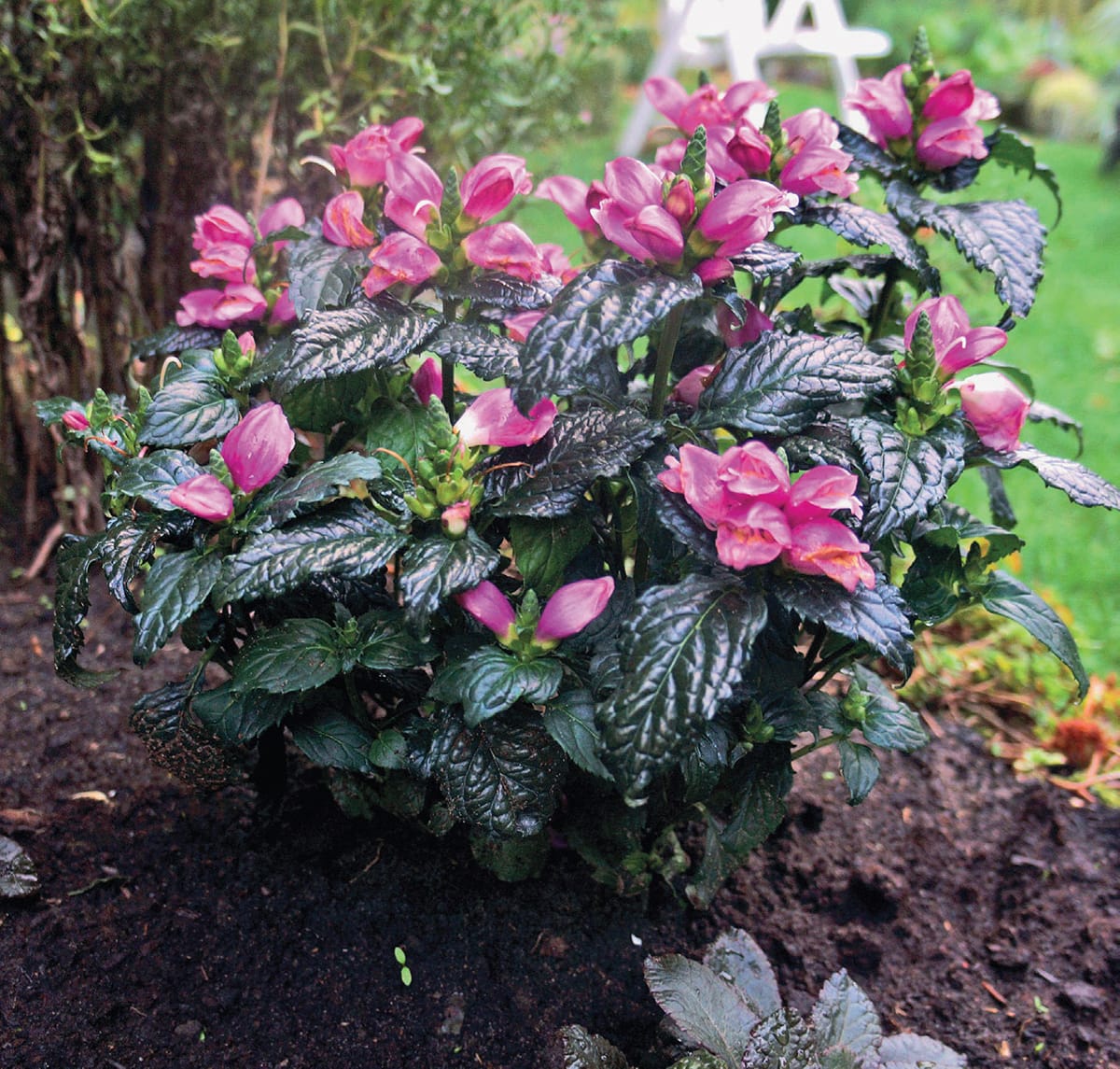
Little Goldstar Black-Eyed Susans
COMMON NAME: Little Goldstar Black-Eyed Susans
BOTANICAL NAME: Rudbeckia fulgida var. sullivantii ‘Little Goldstar’
PLANT TYPE: Flowering perennial
MATURE DIMENSIONS: 12 to 18 inches tall; equal spread
HARDINESS: Winter hardy down to –30°F (USDA Zones 4–9)
IDEAL SUN CONDITIONS: Full to partial sun
BLOOM TIME: July through September
PHYSICAL APPEARANCE: This knee-high version of a perennial favorite is oh so bright and cheerful! Who doesn’t love black-eyed Susans? The flower stalks of ‘Little Goldstar’ are sturdy and upright. Each stalk is highly branched and produces several flowers, smothering the plant in yellow, daisy-like blooms with dark centers for weeks. A cultivar of a North American native plant, this variety hosts many pollinators when in bloom. The leaves are narrow, and the plant forms a cushion-like clump.
CARE REQUIREMENTS: Tolerant of a wide variety of soil conditions, ‘Little Goldstar’ also shrugs off hot, humid summers and drought with ease, though the plants should be kept well watered until established. No pinching or staking is necessary. Divide the plants every few years for improved performance.

Mariachi™ Helen’s Flower
COMMON NAME: Mariachi™ Helen’s Flower
BOTANICAL NAME: Helenium autumnale Mariachi™ series
PLANT TYPE: Flowering perennial
MATURE DIMENSIONS: 18 to 20 inches tall; 20 to 24 inches wide
HARDINESS: Winter hardy down to –40°F (USDA Zones 3–9)
IDEAL SUN CONDITIONS: Full sun
BLOOM TIME: June through September
PHYSICAL APPEARANCE: Helenium is definitely an underrated and underappreciated plant. But, in my mind, nothing compares to the festive blooms of this happy little plant. The Mariachi™ series of helenium offers colorful petals surrounding button-like centers. The varieties in this series bloom in several different shades, including bright red, orange-gold, and yellow. It’s like a party in a plant! Heleniums boast outstanding late-season color and partner well with ornamental grasses and other fall bloomers, like asters and goldenrods. This group of cultivars is derived from a North American native plant and frequently visited by a diversity of pollinators.
CARE REQUIREMENTS: Mariachi™ heleniums prefer moist but well-drained garden soil. A wonderful addition to small-scale borders, beds, containers, and mass plantings, there’s little necessary to maintain these plants. An early pinching encourages more branching and a higher number of flowers, but it isn’t necessary. As an added bonus, the plants are deer resistant and the blooms are colorful additions to bouquets.
